USS Enterprise (1960)
 Nuclear-powered Fleet Aircraft carrier
Nuclear-powered Fleet Aircraft carrier
Cold War USN Carriers:
Essex SBC-27 class | Saipan class CVs (1945) | Midway class | USS United States | Forrestal class | Kitty Hawk class | USS Enterprise | Nimitz class | Gerald Ford classAssault Carriers:
Iwo Jima class | Tarawa class | Wasp class | America class | SCS class | VSS classThe Nuclear aircraft carrier USS Enterprise (1960), probably the most famous ship of the contemporary US Navy, was also in her time the largest ship in the world, exceeded only by the Super-tankers born from the first oil crisis. She remains the largest warship afloat ever built before USS Gerald Ford (launched 2013) displacing 100,000 versus 94,000 long tons Full Load.
She followed the footsteps of USS nautilus (1957), for nuclear propulsion, with the USS Long Beach cruiser (1959), becoming therefore the world’s first nuclear aircraft carrier.
Technically, she followed the logical and evolutionary sequence after the Kitty Hawk and Forrestal classes, but was also equipped with a double ballast hull containing aviation fuel and sea water, with larger dimensions accommodating the largest and most modern air park and its future evolution, and the impressive SPS 32 array. USS Enteprise saw the vietnam war and all the USN operations until deactivation in 2012. Sadly she is still not preserved, like her equally famous forebear, CV-6, but lays in Hampton Roads pending a decision. Enormous for her day, she was still scarcely heavier than the 1945 IJN Shinano.
Happy XMas to all ! #coldwar #USNavy #vietnamwar
Design Development
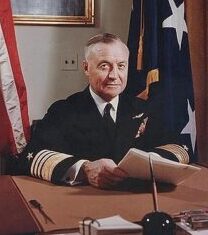 In 1952, prospects for a small, nuclear-powered aircraft carrier were in the air as work on first generation reactors were well underway. Notably under Admiral Rickover’s leadership, and Admiral Forrest Sherman‘s incentive, the first unit to receive a marine reactor would be USS Nautilus. It was not long before another variant was proposed for surface ships. At first, small ones: A serie of escort destroyers, and small aircraft carriers of the kind permanently at sea in one of the several large fleets the US wanted to post around the globe.
In 1952, prospects for a small, nuclear-powered aircraft carrier were in the air as work on first generation reactors were well underway. Notably under Admiral Rickover’s leadership, and Admiral Forrest Sherman‘s incentive, the first unit to receive a marine reactor would be USS Nautilus. It was not long before another variant was proposed for surface ships. At first, small ones: A serie of escort destroyers, and small aircraft carriers of the kind permanently at sea in one of the several large fleets the US wanted to post around the globe.
In mid-1954, as work progressed on both destroyers and small carriers at BuShips, cost estimations reports of 150 billions completely changed this perceptions and optimistic plans. This cost simply caused the abandonment of the SNAC (Small Nuclear Aircraft Carrier) whereas the “destroyer” became a cruiser, the future USS Long Beach. Research resumed after a suspension in August 1954 and this time the aircraft carrier project was to be derived from the Forrestal. The reactor worked out by Westinghouse was to be tested on land as the A1W with an expected unitary output of 35,000hp.
In 1954, the Congress authorized the construction of the world’s first nuclear-powered aircraft carrier, this time in parallel to the new Kitty Hawk class in construction, to be powered by eight nuclear reactors, two dedicated to each of its four propeller shafts as initially thought. This was quite a daring undertaking, since if recent experience was gained into coupling a nuclear reactor to a steam turbine, never two nuclear reactors ever been harnessed together. Engineers started planning the propulsion system long in advance and would be uncertain how it would work or even of it would work according to plans.
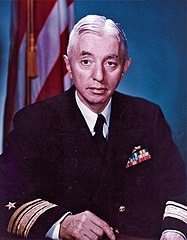 One man was instrumental in this: Admiral Hyman G. Rickover. Already the “father or US Nuclear Submarines” thought of applying this new power source to surface ships use. In December 1945, already Rickover was the Inspector General of the 19th Fleet (west coast) working with General Electric at Schenectady in New York to develop a nuclear propulsion plant, but for destroyers. In 1946, he collaborated with the Manhattan Project’s Clinton Laboratory (Oak Ridge now) around a nuclear electric generating plant. He closely worked with Rear Admiral Earle Mills later named at the heaf of the Bureau of Ships. His difficult relationships with hierarchy however forced him to advocate Nuclear marine propulsion directly to CNO Fleet Admiral Chester Nimitz, a former submariner who soon understood the concept. Its his connection which enabled Secretary of the Navy, John L. Sullivan to order USS Nautilus in 1951, the latter being built in 1952-54, and proving the concept for this propulsion.
One man was instrumental in this: Admiral Hyman G. Rickover. Already the “father or US Nuclear Submarines” thought of applying this new power source to surface ships use. In December 1945, already Rickover was the Inspector General of the 19th Fleet (west coast) working with General Electric at Schenectady in New York to develop a nuclear propulsion plant, but for destroyers. In 1946, he collaborated with the Manhattan Project’s Clinton Laboratory (Oak Ridge now) around a nuclear electric generating plant. He closely worked with Rear Admiral Earle Mills later named at the heaf of the Bureau of Ships. His difficult relationships with hierarchy however forced him to advocate Nuclear marine propulsion directly to CNO Fleet Admiral Chester Nimitz, a former submariner who soon understood the concept. Its his connection which enabled Secretary of the Navy, John L. Sullivan to order USS Nautilus in 1951, the latter being built in 1952-54, and proving the concept for this propulsion.
In between, the STR nuclear reactor (later redesignated S2W) was seen as reliable enough so that another project, which became the A2W (“W” standing for Westinghouse), A related to the ship’s nature, an aircraft carrier, S for a submarine. Rockover, now Director of the Naval Reactors Branch in the Bureau of Ships until 1982 would also direct studies for surface ships using multiple reactors, which was another radical step forward. USS Nautilus only had a single reactor. For a cruiser, or an aircraft carrier, two to four or even eight woud be necessary, a daunting engineering task. But many in the navy already in 1952 saw the use of a nuclear-powered aicraft carriers, both for longer operational stays, unlimited range and shorter upkeep periods. Enthusiasm over a simple draft from BuShips, based on a Forrestal type “super-carrier” soon drew the prospect of a full class of six ships.
SBC-127 and 160: The nuclear and the conventional backup programs
This came however in apparent conflict with a parallel line of development: The Kitty hawk class conventional carriers. Project SCB 127 was in fact seen as the “sixth and seventh” Forrestals, only improved. The 1953 new nuclear-powered class, soon designated project SBC 160 was to be their logical, natural succession. Design innovations of SBC-127 would help in the meantime securing the basic design, with modifications, of SBC-160. Notably instead of 5-in guns, the first three of the new class authorized in 1954 (CV-63 was laid down in 1955) would be constructed with a Terrier surface-to-air missile system, and so were the SBC-160. The latter also had to test a new radar setup in project.
So that year of 1954, both designs, the conventional SBC-127 and the nuclear SBC-160 were authorized, with the idea the first could serve as a backup while providing to the fleet’s future needs in case SBC-160 proved unfeasible. That was quite a bold move for the USN, and soon the cream of engineers went into SBC-160’s program, which was estimated to take longer, with reason.
The proposal of late 1953 was approved in 1954, but it took time before assignation to the very experienced Newport News Shipbuilding yard in Virginia. Nearly four years (1958 when she was laid down) were needed to generate miles of blueprints and sold on paper many engineering issues. USS Long Beach (CGN-9) built in parallel, laid down earlier on 2 December 1957, also helped to solve may engineering issues related to the coupling of multiple reactors. She still used “only” C1W nuclear reactors (W for Westinghouse, “C” for cruisers”) which were a derivative version of USS Nautilus’ S2W. The main differene between Long Beach and CVN-65 was that each C1W nuclear reactors was coupled with a single General Electric turbines for a total of 80,000 shp (60 MW). Ths system was basically just a duplication of Nautilus’ powerplant.
On CVN-65 case, two reactors were to be coupled to a single turbine, which including quite extensive gearbox, reduction, control and electrical specificities. It dragged on the development time for two years.
Consolidation of SCB 160 design
Project SCB 160 was intended as the first of six carriers at first. However over the years, the massive construction cost overruns led to a cancellation of CV-66 and 67, which instead were completed as the last two Kitty-Hawk class.
USS Enterprise’s eight-reactor propulsion design, with these coupled A2W reactors replacing conventional boilers in previous designs still helped keeping as much of the previous designs as possible. But the coupling and its control was a dunting task. Due to her large size and displacement, engineers tried to improve her agility, and she was the only carrier fitted with four rudders for redundancy, two more than previous ships, but also her hydraulic profile was much refined, to the point of fitting her with a cruiser-like hull.
As for SCB 127C (USS John F. Kennedy, CV-67) she was originally scheduled as a fourth Kitty Hawk-class carrier but received ton of extra modifications and ultimately formed her own class, including a proposal to retrofit her as a second nuclear powered carrier, project SCB 211A. Congress at the time however, “warmed up” by reports of massive costs overruns for the SBC-160 did not authorize it. In reality, CV-67 ended more as a prototype for the Nimitz class (which were nuclear-powered), as a blend between the two designs, the costly Enteprise and more reasonable Kennedy.
Final Design
USS Enterprise being the first US nuclear carrier, her size was dictated by this particular power plant, not much heavier than for a conventional ship, but imposing special protection measures for the crew and which needed a liquid load for underwater protection, greatly increasing her displacement, and mainly used for aviation gasoline, allowing her to operate a very large large air group.
This aviation fuel stowage was initially dictated by concerns of underwater protection, not operating a larger air group and earlier this storage was balanced with the ship’s overall endurance and more reasonable (like in the Kitty Hawk class). But it was so generous that it was proposed that ship auxiliary boilers would be modified to inject aviation fuel (JP-5) and boost the burn rate. The increase of ordnance was also significant, from 2,000 to 2,520t.
These advantages meant she was capable to operate in high-intensity for 12 days days without replenishment. Other innovations were on the electronics side, with the brand new electronically scanned main radars SPS-32 and SPS-33 and their caracteristic final shape, also shared by the nuclear-powered USS Long beach, escort missile cruiser. There was still a conventional radar as backup.
Another amazing fact was that CVN-65 was planned to be armed like other conventional carriers, and engineers secured sponson’s space to accomodate the Terrier missile fitted on CVA 63, 64 and 66 but she was never fitted fitted with the installation to reduce costs. Total trust was instead transferred to the couple SPS-32/33 and greater aior group to intercept any incoming threat at long range.
Construction
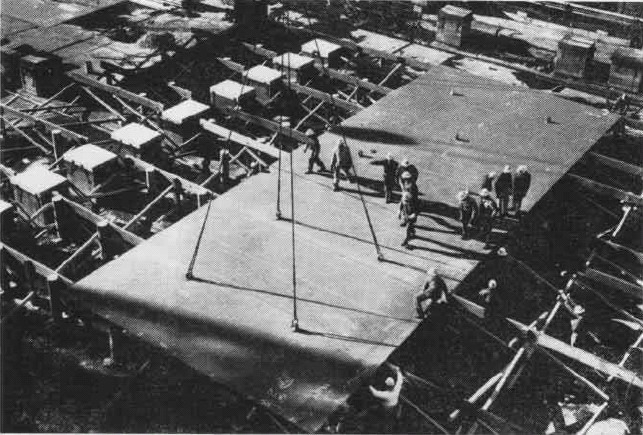
Keel Laying ceremony in 1958
All in all, the design of CVN-65 required 915 designers, which produced together 16,100, later summup into some 2,400 blueprints. The Original Cost was calculated to $451.3 million, including the construction, making her the costier warship in US history. Materials gathered used by the shipyard included 60,923 tons of steel but also 1,507 tons of aluminum mostly for the superstructures, internal and upper parts, plus some 230 miles of pipe and tubing as well as 1,700 tons of one-quarter-inch welding rods. They were supplied from more than 800 companies. In addition to the design staff, 900 shipyard engineers assisted designers to pass the millions of blueprints created (the equivalent of 2,400 miles of chained paper from Miami to Los Angeles) in the three years and nine months needed total at Newport News Shipbuilding and Drydock Company until her launch a Saturday morning, Sept. 24, 1960. Mrs. William B. Franke, wife of former Secretary of the Navy, launched the usual Champaign bottle and christened the eighth USS ENTERPRISE.
She was unveiled to the world as “The First, The Finest” super carrier. Capt. Vincent P. de Poix, which assisted the completion was her first commander.
When commissioned, Secretary of the Navy John B. Connally Jr. called it a worthy successor to WW2’s USS Enterprise, “The fighting Gray Lady”, and added “The new Enterprise will reign a long, long time as queen of the seas.” She soon became a tour of NATO allies, as the “free world’s best asset”. She was also soon called simply the “Big E”.
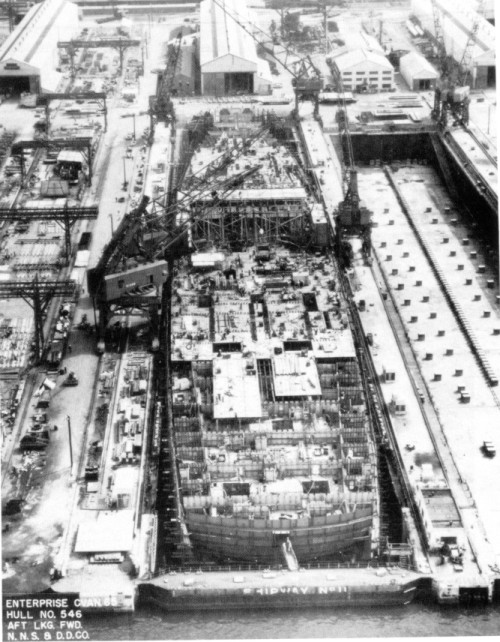
CVAN-65 during construction
The paradox was that in the meantime, the fourth Kitty-Hawk class carrier, USS J.F Kennedy, freshly renamed after the president’s assassination, was to be originally a sister-ship of USS Enteprise, but ended as a conventional super carrier, the last ever completed, on 7 September 1968 as CV-67. CV-65 was also completed before another Kitty Hawk, CV-66 USS America (23 January 1965). Both were started in 1960 and 1964 and benefited from an influx of design innovations from USS Enteprise, especially USS F.J. Kennedy.
About her name:
She was the 8th ship to bear this name, after CV-6 USS Enteprise, which WW2 career was nothing short of amazing and which after her removal from the lists in 1959 freed the name. The choice was obvious, but “enterprise” (also bore by British vessels), was originally asociated to celebrate capitalism in sense of the pre-industrial era, in the United Kingdom. The first first US ship was indeed a British one, captured from by Benedict Arnold in 1775 (and burn to avoid recapture). The name was later bore by a privateerlater purchased by the Continental Navy in 1776. The 3rd was a schooner built in 1799 which patrolled the Caribbean, protecting American interests from French privateers during the “quasi-war”. Later, she joined the Constitution off Barbary Coast, famously part of the battle of Tripoli. Next followed a NyC schooner in service 1832-44, then a barque-rigged screw sloop-of-war of 1876, and a… 66-footer motor patrol boat in service WWI. Nothing really prestigious. Until it was chosen for the Yorktown-class fleet carriers, more as a rememberance of the revolutionary war.
CVN-65 Motto was “READY ON ARRIVAL”. A space shuttle was also named that way, inspired by Star Trek’s flagship, itself inspired by CVN-65 based on its innovative flavour and scale.
Detailed design of CVN-65
Hull
The CVN-65 hull borrowed a lot to previous designs, with a fully encased “hurricane bow”, reinforced prow, and prominent bulbous bow, instead of a straight line. The most caracteristic was the hull lines which were refined into a so-called “cruiser hull” design. The prow showed openings for all three anchor lines. The stern was squarish, something started with USS Forrestal. All in all, she could have finer shapes at the waterline, but above it fuller shapes in order to support a wider flight deck. Indeed her beam went from 132.8 ft (40.5 m) at waterline level, versus 130 ft (40 m) waterline for the Kitty Hawk class, yet this figure rose to 257.2 ft (78.4 m) extreme width at flight deck level, versus for JF Kennedy 252 ft (77 m) at the extreme. This made, with a hull 1,088 ft (332 m) long originally versus 1,052 ft (321 m) overall for a roomier flight deck surface.
Ship protection:
Armour protection was way more limited than a Midway class and more in line with the Forrestal: She had four protected decks, plus a distributed vertical armour comprising STS side armour and longitudinal bulkheads. The was a belt 8 in (20 cm) thick in aluminum, equivalent to 4 in (10 cm) rolled homogeneous steel armor, and an armored flight deck, hangar, magazines and reactor.
There was a solid compartimentation under the waterline with a compression zone, filled with “liquid” and replaced mostly with aviation gazoline. There was however a box-shaped protection of the magazines and vital zones, like over the steering room, while all the regular avgas tanks were buried dep within, box-protected. The Underwater protection total included five longitudinal bulkheads, with a fourth bulkheads 76 mm-thick (3-in). This sandwich alternating filled and void comparments was supposed to dissipate a warhead explosion. The double Bottom was also protected by thicker plating. The usual safe fuel lines were used, developed from the Essex class, with seawater fill when not in use and safety valves. There were also flash doors for the ordnance lifts. All lifts were external.
Among safety measures, the same recipes applied to previous ships were reused. CVN-65 had 17 flight deck outlets 7 hangar deck outlest, four flight deck with 5 w/2 and 2 w/3 Hoses per outlet (2.5-inch hose), two hangar deck (1 w/3), and 100 Defueling capacity per outlet/portable hose, 25 gpm. Originally, CVN-65 was designed to operate both Jets and piston aircraft, fueled with aviation gasoline, which very similar to motor gasoline and quite hazardous. JP-4 was used for jets, analong to commercial Jet B, as standard for the USAAF and USNAF. The Air Force converted to JP-8 later, but the Navy only followed for shore-based aircraft. JP-8 is identical to commercial aircraft, “Jet-A1”, which has a flashpoint of 100°F minimum, reducing risks.
This transition was never made despite some pressure in the 1990s. No JP-8 compatible US Jet is allowed on an aicraft carrier, and instead the Navy restricts carrier operations to the use of JP-5, which has a 140° F minimal ignition point, so much safer. Special features prevent self-ignition risks on the flight deck while in hot climates and around the catapults, which temp. can reach 200°F.
Especially after the great 1969 fire onboard USS Enteprise a list of ignition origin was listed to be under scrutiny at all times by dedicated safety personal, such as hot engines, exhaust from engines, yellow gear (aviation support equipment), exhaust from starting carts (its one of these that caused the initial fire on USS Enterprise). But inside the ship, electrical arcing and
sparking potential is there, revealed notably via cutting and welding, as well as static discharges and electromagnetic radiation, the catapult steam lines. Plus the exceptional, such as aircraft crashes and (accidental) firing of ordnance.
When USS Enterprise was just being built, a serie of Firefighting agents were tested in US labs. The most prevalent one was AFFF, called “Light Water” when introduced in the Navy in the 1960s. It caused an aqueous film to float on the top surface of fuel and due to specific gravity differences, water settles to the bottom, the fuel floats on top, caused by surface-tension effects created by the fluorocarbon surfactants. Although introduced on NAS first, it came to Aicraft carriers in the 1970s, so after the great fire. Using protein foam, and pn a gallon-for-gallon basis, AFFF is able to put the fire out three times as fast with only one-third as much agent. For more portable systems, Dry chemicals were used such as the standardized potassium bicarbonat PKP in Halon 1211 for portable extinguishers and used by the P-25 crash truck aboard, essentially a fire fighting vehicle. All this was completed by seawater hose stations around the flight deck, plus extra ones carried in portable extinguishers in the “crash and smash locker” in the island.
Powerplant
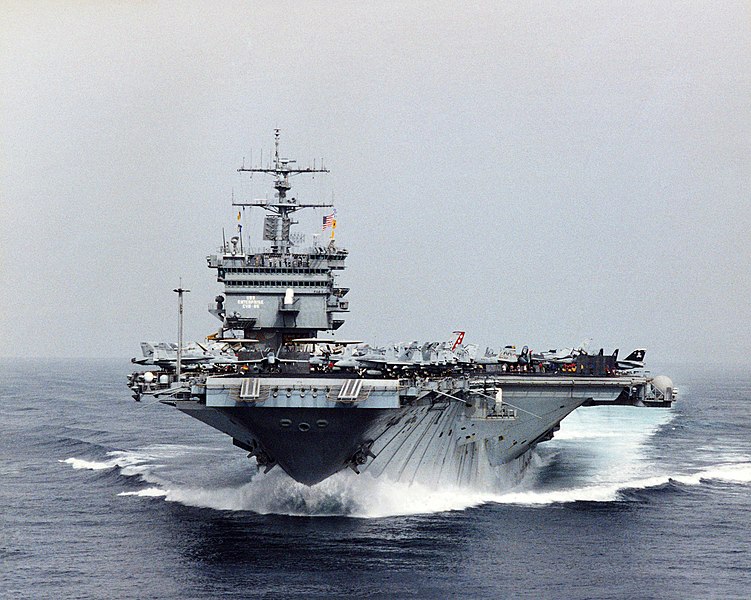
Work on nuclear marine propulsion in the US started in 1946-47, with the first operational reactor operational by 1953 and aside Hyman Rickover, Admiral Forrest P. Sherman CNO in 1949 proposed a nuclear-powered aircraft carrier which was later to be translated as CVN-65. Technology was setup already from 1951 but Oak Ridge tests were halted in 1953 by a national security council order and resumed in late 1954 with the “large ship reactor project” (LSRP). Compared to land installation it needed compact construction but can be limited to only 200 MW and more stable, for lighter control and staff. The pressurized water type reactor which resulted of this had both a smaller core in a tighter space, with highly enriched fuel, less extensive shielding. The Mark 1 reactor culd deliver 60 MW (from Shippingport in Pennsylvania), operational in 1957.
But it’s Westinghouse which designed a 250 MW model, Yankee Rowe, starting operations in 1960, at the same time as the Argonne National Laboratory boiling water reactor (BWR).
Naval Nuclear Powerplant A2W

The C1W reactor was chosen for USS Long Beach and its development, simpler than for CVN-65 was led by the Westinghouse Electric Corp. Arco facility, in operation from October 1958.
The A1W plant was the land-based prototype for the new carrier’s plants. It was built at the Naval Reactors Facility in Idaho, and this land-based prototype comprised two units, designated A and B, built within a portion of a steel hull to replicate the ship’s engine room, powering a shaft through a single geared turbine propulsion unit. It derived from the 1955’s S1W. The navy wanted for a single shaft and output of around 70,000 SHP, a quarter of the cenventional propulsion of USS Forrestal. This prototyping meant there was no transition to “real” construction and the original A1W could stay on land for training personel. Both A1W and A2W designs had their coolant kept at 525-545 °F (274-285 °C) and in the steam generators, a pressure of 600 Psi at 535 °F (279 °C) was expected.
In CV-65 the final A2W combined a single A1W-A and a A1W-B units operating in tandem, on one turbine. This A3W reactor was also to be fitted on USS John F. kennedy until further refined into the A4W installed on USS Nimitz (CVN-68). The amazing fact was that the keel was laid down well before A1W reached its initial criticality and tests were still ongoing when she was launched. But the final combined A2W unit was ready to be shipped afterwards for completion. The whole process denoted great trust from the project’s proponents and the Navy as no delays were encountered during the completion phase, or during trials. Eventually by having eight Westinghouse A2W pressurized water reactors (PWR) in their four separate engine rooms, plus their own confinement cells, duplicated controls and safety backups, ensure long term operations even in a war zone, which was the case during USS Enterprise’s early career.
Finalized Powerplant
Four shafts, connected to four Westinghouse geared steam turbines, fed in turn by four Westinghouse A2W (acronym: A for Aircraft Carrier, 2 for second generation, W for Westinghouse) nuclear reactors, for a total of 280,000 shp (210 MW). The Westinghouse Turbines were connected to each a pair of reactors (1A – 1B, 2A – 2B, 3A – 3B, 4A – 4B), each rated for circa 150 MWt. The core life diverged, Cores 1 & 2 operated for 3 years, Cores 3 & 4 for an average 18.9 year. The steam power also fed many sub-systems, such as the four catapults, pretty hungry as jet aicraft grew in size considerably over time. But long stury short, these installation proved costly but safe. No nuclear incident was ever reported. The 280,000 MW were a dependable source of power at all times, which implied unlike classic boilers, which needed time to be heated up, these reactors were “heated” already when the ship was at anchor and technically “cold”. This power was there for all inboard systems in addition to the usual diesel generators used as APU rto supply electric current to the also power-hungry electronics suite.
Performances
Top Speed of USS Enteprise was 33.6 knots (38.7 mph; 62.2 km/h) as specified. Sea trials remains classified to this day, some authors affirming they would have no problem reaching 38+ knots of needed. Of course range was also unlimited, with a 20–25 years before the core change. Importantly, compared to previous designs, CV-65 had four 4-bladed propellers, 32 tons each and four rudders weighted 35 tons each, less in fact than her two anchors, 30 tons each.
A first in life end’s as well
Another aspect which was brand new in 2017 when USS Enteprise was decommissioned, was its “denuclearization”. Although major critical components were made of corrosion resistant nickel iron alloys, none really had an idea of the scale of degradation over so many years since she was commissioned. Replacing the core did not meant a full, torough inspection of all components. Thus in 2017, when sent at the Puget Sound Naval Shipyard & Intermediate Maintenance Facility to prepare the reactor compartments for disposal, this was uncharted territory. The standards that were required, also for recycling of components wrote the book concerning the fate of all Nimitz class aicraft carriers.
Auxiliary Power
USS Enteprise was equipped with diesel emergency generators to provide onboard electrical systems, in case the nuclear reactor were not able to provide the electricity aboard, through a derivation. See also. Details are unknown but they were overhauled and replaced in 1980.
Armament
The cost of construction consicted the radical decision of not equipping CVAN-65 with the interned RIM-2 Terrier missile launchers, leaving there “unprotected”. In reality she was under the tripple bubble of long-range and short range missiles of escorts, plus her own air group. However late in 1967, she received a prototype Basic Point Defense Missile System (BPDMS) installation. It consisted in two eight-round box launchers, each with a short range Sea Sparrow missile. A third BPDMS was fitted during also in 1970–1971.
Next these were updated with the new NATO Sea Sparrow (NSSM) and in the 1980s, three Mk 15 Phalanx CIWS mounts were installed for anti-missile defence, one later removed, replaced by two 21-cell RIM-116 Rolling Airframe Missile (RAM) launchers, the armament with which she ended her carrer.
BPDMS:
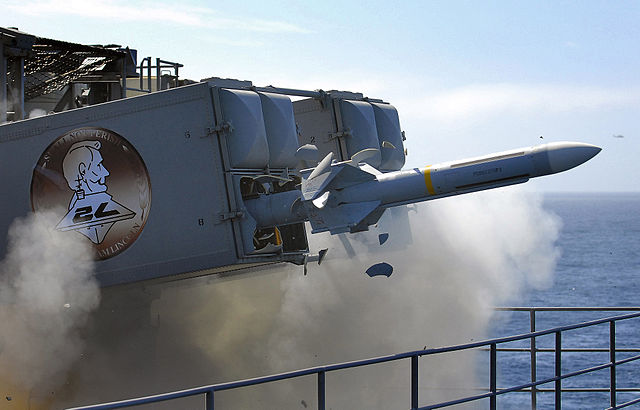
The RIM-7 Sea Sparrow was a derivative of the well-known air-to-air missile developed in the 1960s. The AIM-7E from the F-4 Phantom was adapted to shipboard use with surprising speed. The Basic point defense missile system was developed to procure any ship in the USN with limited space with a simple short range point defence SAM. It consisted in a single mount with two pairs of four canister launchers which had traverse and elevation. It was assited by a Mark 115 manned direction systems using illumination.
Each missile weighted 510 lb (230 kg), measured 12 ft (3.7 m) by 8 in (20 cm) in diameter, wingspan when deployed 3 ft 4 in (1.02 m). It carried a proximity fuzed, expanding rod warhead (27 ft (8.2 m) kill radius). It was propelled by an Hercules MK-58 solid-propellant rocket motor to 10 nmi (19 km) at 4,256 km/h (2,645 mph) and guided by semi-active radar homing.
RIM-166 RAM:
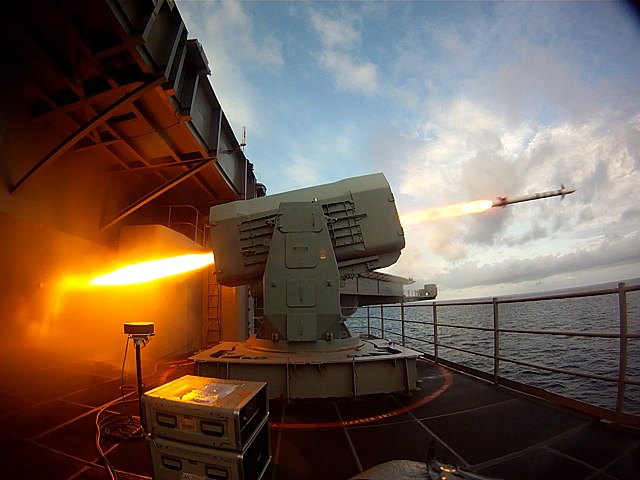
The last system installed on CVN-65, it was designed to replace the BPDMS, also as short-range. However the launcher had more vectors. It was developed by Raytheon, Diehl BGT Defence by the 1980s and entered service in 1992. Thesystem fired guided rockets 73.5 kg (162 lb)2.79 m (9 ft 2 in) long, 127 mm (5.0 in) in diameter, with a fin span of 434 mm (1 ft 5.1 in)/ Each was capable of Mach 2.0+, carrying a 11.3 kg (24.9 lb) blast fragmentation warhead and had a 10 km range (6.2 mi). Each of these used three guidance modes, passive radio frequency or infrared homing or infrared/radio dual-mode. The missile is basically a derivative of the famous AIM-9 Sidewinder. Each launcher had 21 tubes (so 21 missiles).
Upgrades
For armament in September 1966 she received two octuple Sea Sparrow SAM (16 RIM-7) and in 1982, three more Sea Sparrow SAM (Mk 57) and three six-tubes 20mm/76 Mk 15 Phalanx.
By 2005 she received one more Phalanx CIWS and two 21-tubes RAM SAM (42 RIM-116).
Sensors
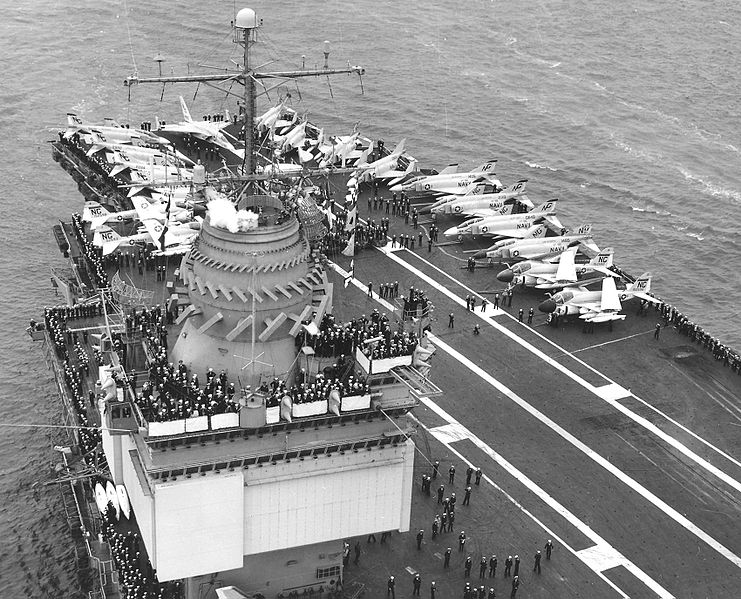
In total, the USS Enteprise was fitted with the SPS-10, SPS-32, SPS-33, SPN-6, SPN-10, SPN-12 radars and the ULQ-6 ECM suite.
But when she entered service, she had one of the most ambitious system ever developed by the USN and arguably -by any nation to that point. CVN-65 was the second ship (after USS Long Beach) equipped with SCANFAR.
SCANFAR (1960)
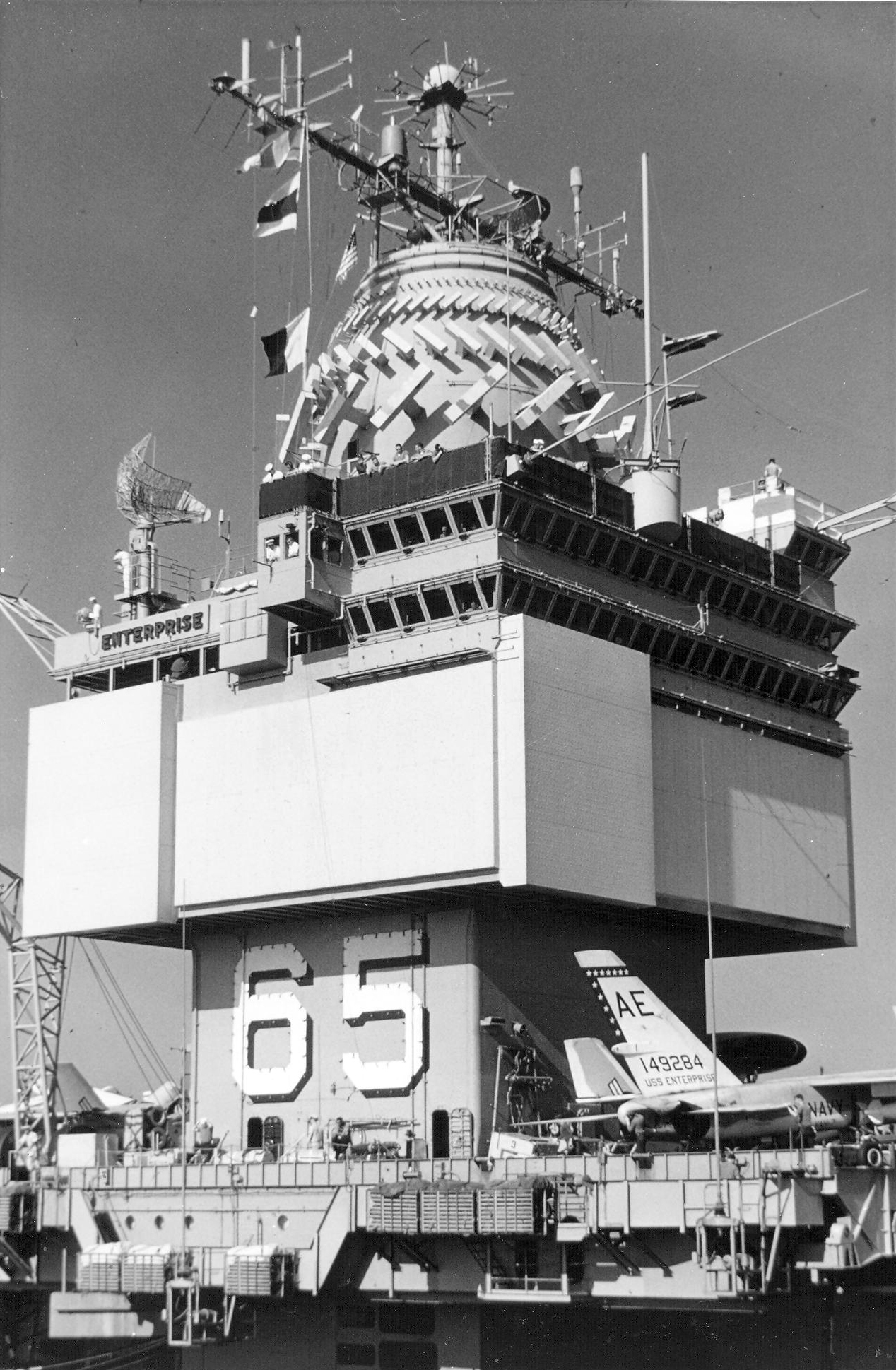
SCANFAR was in short, an early ancestor of AEGIS. It was a multiple airborne targets tracking systm, whereas conventional rotating antenna radars of the time could only track one. SCANFAR comprised two radars, the AN/SPS-32 and the AN/SPS-33. The first was the Hugues long-range air search and target acquisition radar, completed by AN/SPS-32, the large square array used for 3D tracking, whuch when combined formed a massive “cube” over and under which were installed the bridges on the carrier’s island. This system was not only huge, it was complex, sensible, and took a massive power drain on the electric system. All the AN/SPS-32 vacuum tubes broke often and needed constant replacement, which proved a nightmare on the long run. The SPS-32 had a range of 400 nautical miles (large targets) down to 200 (fighter-size).
EEW Andrew Alford AA-8200:
In addition there bridge was topped by a caracteristic dome containing a new tailored electronic warfare suite Andrew Alford AA-8200 dipole antennas, six rows of antennae around, the upper rows being encased in fragile piping radomes. This other complex and costly system, which never received a navy designation, was latter eliminated.
Deletion
The whole system was deemed obsolete and replaced around 1980, the island being completely modified under the lines of the Nimitz class. Although SCANFAR was ahead of its time, its electrical beam steering mechanism was problematic and USS Enteprise was the only ship, apart long Beach to use it. These humble beginnings into the “phased array” type radar would evolved and mature many years later as the Aegis AN/SPY-1, far more reliable and practical.
Electronics Upgrades
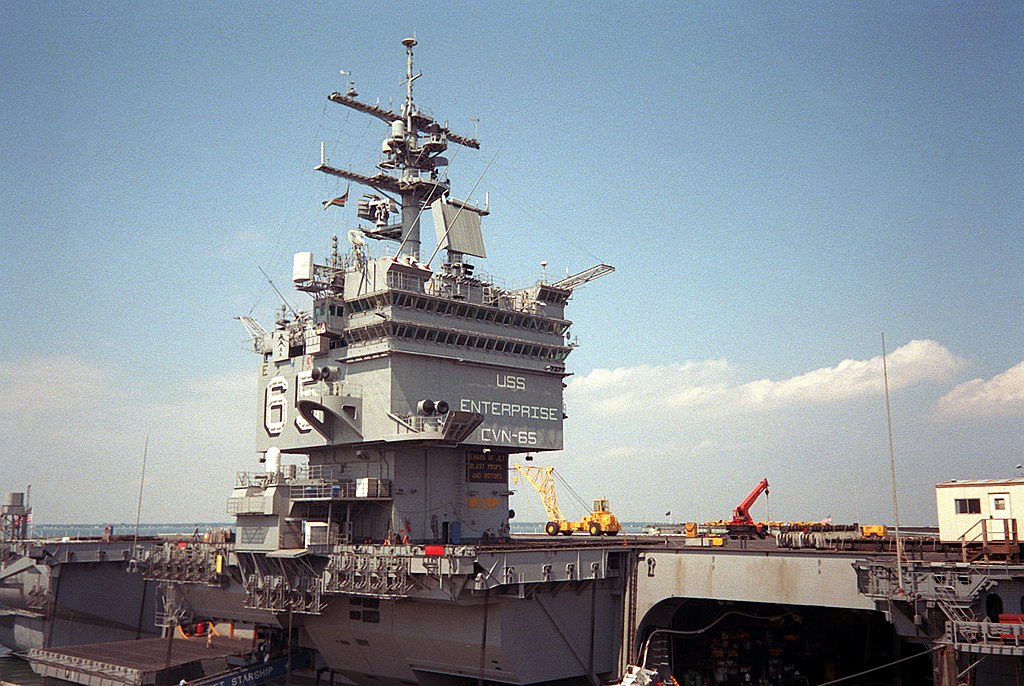
CVN-65 Island in 1990
In the 1960s she had the SPN-6 radar and ULQ-6 ECM suite but received in addition the SPN-35A radar, and the WLR-1, WLR-3, WLR-11 ECM suite.
In September 1966 to assist her new Sea Sparrow launchers, she receiced two Mk 51 and SPS-58 radars.
In 1968 she received a SPS-12 radar. However the greates updrade was in February 1982:
She had the SPS-32, SPS-33, SPS-10, SPS-58, SPN-10 and SPN-12 radars, but received the LN-66 and six Mk 95 fire control radars, as well as the SPS-48C, SPS-49, SPS-65, SPN-41, SPN-42, SPN-44 radars plus three Mk 90 FCS radars and the new WLR-8 and SLQ-17(v)4 ECM suites (SLQ-29 system), as well for chaff defence, four Mk 36 SRBOC decoy RL systems and the TFCC. For satnav she received an upgraded NTDS and the ASCAC system.
The last modernization phase was in the early 1990s: Sge received the SPS-73, SPS-64(v)9, SPS-67(v)1, SPS-48E, SPS-49(v)5, SPN-43A radars as well as for fire control, two SPN-46, and a Mk 23 TAS radar. For electronic warfare, she had the WLR-1H(v)7, the new SLQ-32(v)4 ECM suite, the upgraded Mk 35 SRBOC decoy launchers and the SLQ-25A SSTDS torpedo decoy system.
The ultimate addition was in 2005 when she received a Mk 90 radar.
Aircraft Facilities
The total operation area represented 20,400 m², or 6,537 m² acres, with a hangar internal volume of 49,680 m³. The Flight deck measured 331.6 by 77.7m in width, greater than any previous class. The The Flight Deck Area represented 4.5 acres (18,211 m2). She had four catapults, two at the forward deck section, two on the angled landing strip section admidships, using the same model. She also a jet blast deflector barrier behind each of the catapult, a fixed crash barrier mid-way aft on the landing deck, two net barriers and four arrestor cables, with hydraulic braking systems.
Flight Deck vehicles:

At sea aboard USS Theodore Roosevelt (CVN 71) Jan. 27, 2003 — An aircraft tow tractor moves an S-3B “Viking” assigned to the “Scouts” of Sea Control Squadron Two Four (VS-24) into position on the shipÕs flight deck. Roosevelt is conducting training exercises in the Caribbean Sea, while preparing to deploy to the Central Command Area of Responsibility. U.S. Navy photo by PhotographerÕs Mate 1st Class James Foehl. (RELEASED)
A rarely discussed topic. On the WW2 carriers of the Essex class and Midway, “classics” were the Clark tractor 6 introduced on its aircraft carriers since mid 1942, for towing piston-engine aircraft, including the large Avenger. From late 1943 was introduced the BNO-40 Flight Deck Tractor, used up to years after the Korean war. It was still used for piston-engine aicrafts, but with the new jets weight, a more powerful vehicle was required. Thus, the MD-1 Flight Deck Tractor was introduced in the early 1950s, first dedicated jets tractor. MD-1s were notably employed to start up aircraft jet engines prior to takeoff, using gas turbine start units. They were used on the modernized Essex and on the Forrestal class.
At the time of the CVN-65 construction (and the later Kitty Hawk class CV-66-67), the MD-3 Flight Deck Tractor was about to be introduced. It was capable of handling jets that were potentially on the 15 tonnes range, such as the 26,600 lb (12,066 kg) Grumman Tracer, but not the massive North American A-5 Vigilante (63,085 lb (28,615 kg) GRW). This was however the first US purpose-built shipboard tractor, and in standard had the jet aircraft start unit, housing a gas turbine air compressor. It was also adopted for the first US helicopter carriers. Next came the A/S32A-31A Flight Deck Tractor, capable of towing much heavier models, it became the second stanndard for the Kitty Hawk class, USS Enterprise but also the Nimitz class carriers (and is still used today) as the A/S32A-32A Hangar Deck Tractor. As for personal transport plus aircraft towing vehicle, the good old WW2 Willys Jeep was used, and maintained up to the 1950s, before being replaced by dedicated tractors or the CJ3A (G503) starter/towing Jeep. She was also equipped with the A/S 32A-35 Crash crane vehicle.
ref
Hangar:
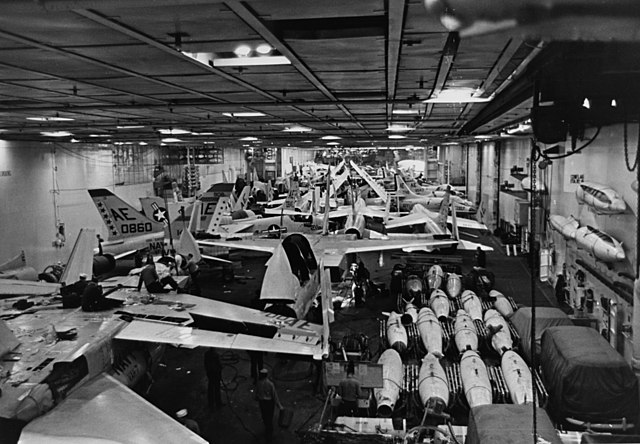
Hangar view in 1964
The Hangar measured 223.1m x 29.3m x 7.60 m (731 x 95 x 25 ft). The main tranverse aft landing Area was 104,85 meters (344 feet). Internal hangar aircraft Capacity was 75 aicraft, the remainder being parked outside, and the Hangar Bay Area was 3.5 acres (14,165 m2).
Catapults: Four C13 catapults, steam-powered, 286 feet (87,2 meters) long. They were steam-powered, and the largest ever fitted on an aircraft carrier. In theory they could launch a fully loaded 20 tons aicraft, which proved handy when dealing with monsters such as the Skywarrior and the Vigilante.
Elevators: There were four deck-edge elevators, 40t, 21.4/25.9 x 15.9m (70/85 x 52 ft) instead of three on the Kitty Hawk and Forrestal classes.
Aircraft fuel stowage: 363,300 l of petrol and 9,380,000 l of JP-5 jet fuel.
Aviation ordnance stowage: 1,800t (since early 1970s 2,524t).
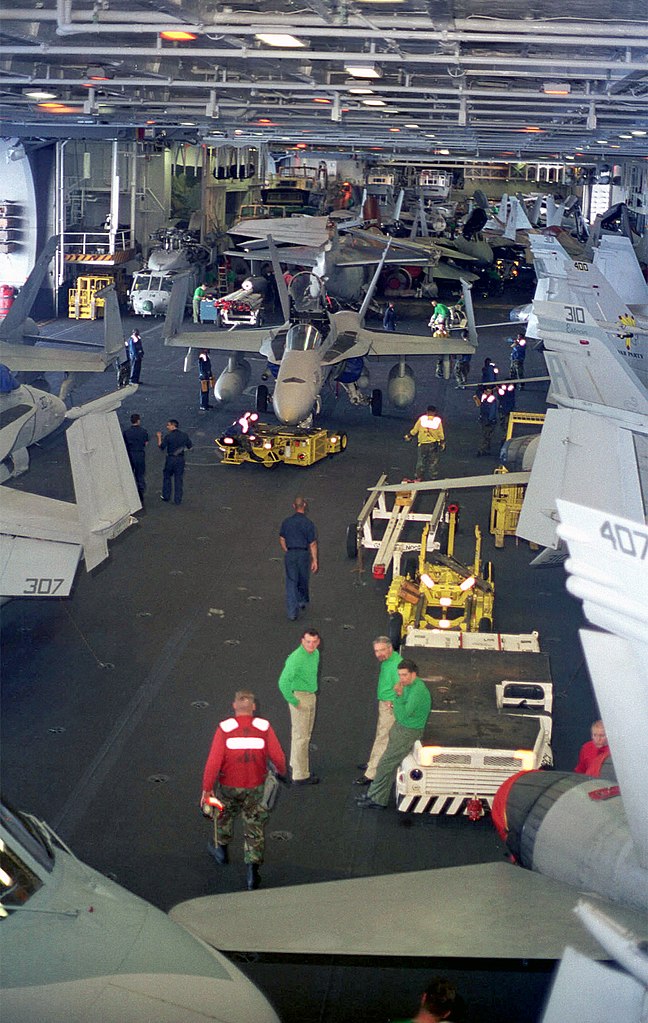
Air Group
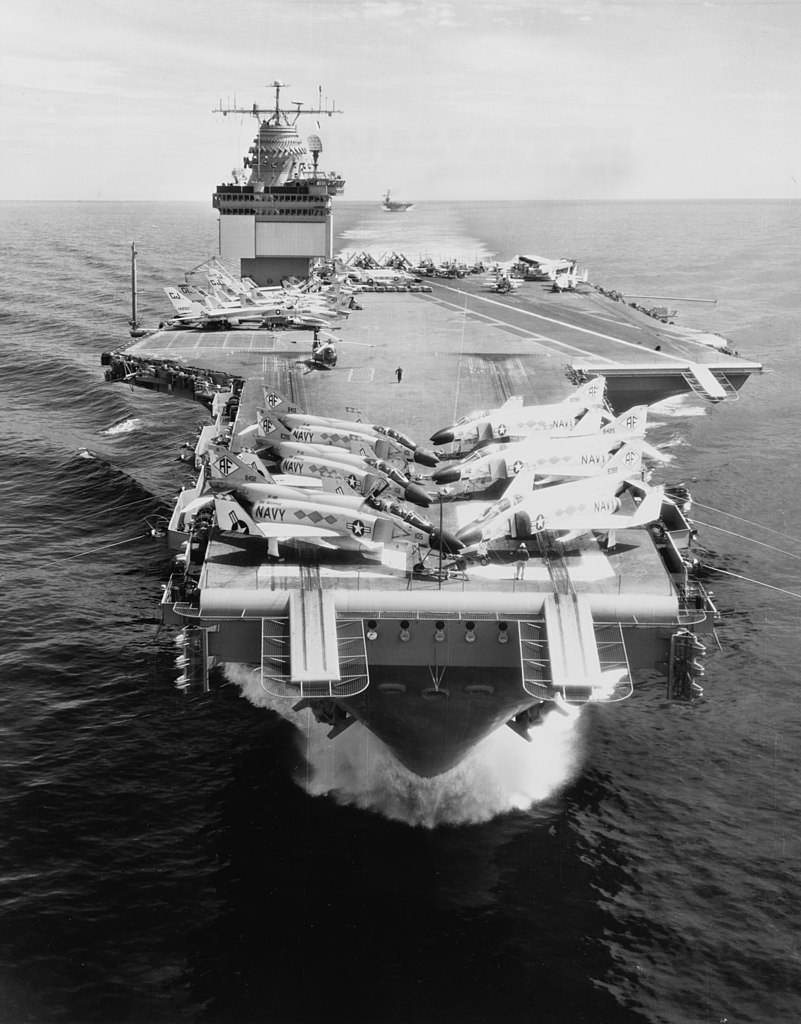
As initially defined, it revolved around 90 aircraft. Back in 1960 there were planned to be possibly the following fighters:
-North American FJ Fury, McDonell F2H Banshee, Grumman F9F Panther, McDonnell F3H Demon, Douglas F4D Skyray, Vought F8U Crusader, McDonell F4H Phantom II.
As for attackers, the Douglas AD Skyraider A3D Skywarrior, A4D Skyhawk as well as the reconnaissance versions F2H-P, F9F-P, OE, A3D-P, F8U-P, F4H-P. AD-Q, F3D-Q, A3D-Q ECM planes, AD-W, WF EW planes, S2F ASW planes, TF cargo planes, HRS, HUP, HSS, HUS, HOK, HUK, HUL, HR2S, HSS-2 helicopters. A wide panel, but in reality it was more modern and simpler when completed.
Early Air Group
In 1966 she allegedly carried tenty-four F-4B Phantom II fighters, twenty-four Douglas A-4C Skyhawk, twelve A-6A Intruder, six A-3B Skywarrior and three RA-5C Phantom II, three RA-3B Skywarrior, three EA-3B Skywarrior, four E-2A Tracker and four Kaman UH-2A Seasprite ASW/SAR helicopters.

Author’s rendition of a F8E Crusader superiority fighter from VF33, CVAN 65 (USS Enterprise) circa 1962, first certification flights.

F4B Phantom II from VF-143, CVAN-65
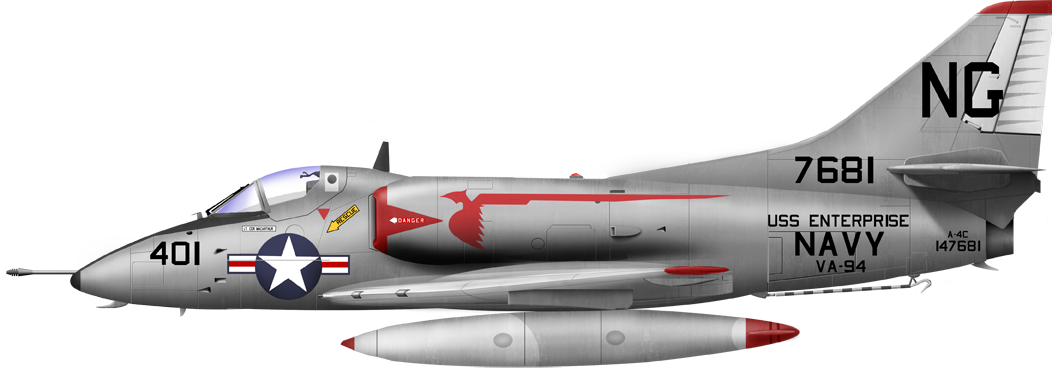
Douglas A4C Skyhawk, VA-94, USS Enterprise

Author’s rendition of the North American A5A Vigilante, VAH-7 “Peacemakers”, CVAN-65, 1962

Douglas A1H Skyraider, VA-65, USS Enterprise 1965
Early air Group, at the time of the Vietnam War, artwork by Artwork by Stéphane Garnaud on navsource.
1970-80s Air Group
From 1975 and for the 1980s, she operated about the same air group, composed of the following:
-twenty-four Grumman F-14A Tomcat Fighters
-Twenty four Grumman A-7E Intruder attackers
-Twelve Vought A-6A Corsair II Attackers
-Three North Am. RA-5C Vigilante reconnaissance aicraft (long range, high speed)
-Four Grumman EA-6B prowler EW aircrafts
-Four Northrop Grumman E-2A Hawkeye long range surveillance aircraft
-Four KA-6D and ten S-3A or eight SH-3H helicopter for ASW/SAR.
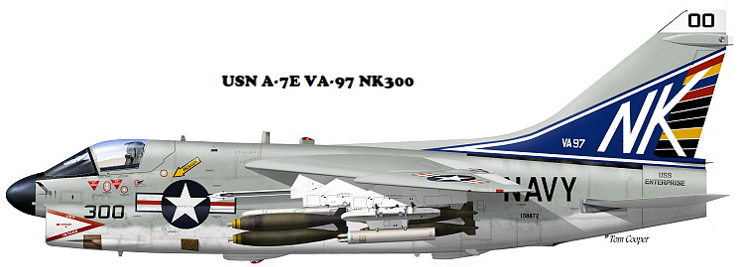
Vought A7E Corsair II, VA97
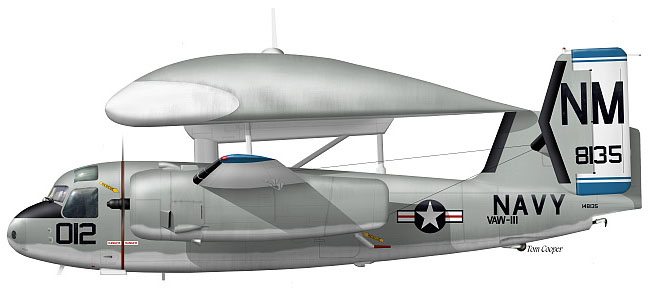
Grumman E1B Tracer, VAW-111
1990-2000s Air Group
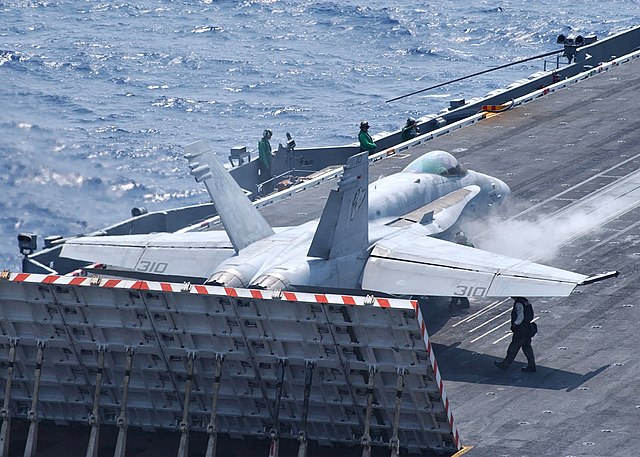
In 1999 she had twenty F-14A completed by no less than 36 F/A-18A/C multirole fighters and still four EA-6B, 4 E-2C and 6 S-3A, 4 SH-60F helicopters.
In 2003 she operated only ten F-14B, twelve F/A-18A+ and twenty-four F/A-18C, in complement were four EA-6B, and four E-2C and for helicopters, eight 8 S-3B, six SH-60F, two HH-60H.
In 2006 her last air group comprised twenty-four F/A-18E/F, and the same of F/A-18A/C (48 Hornet in all), plus four EA-6B, 4E-2C and two C-2A transport planes, plus six SH-60F/HH-60H helicopters.
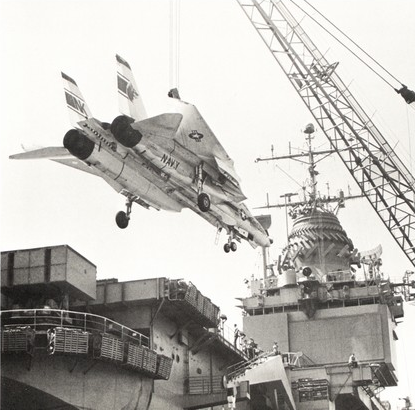
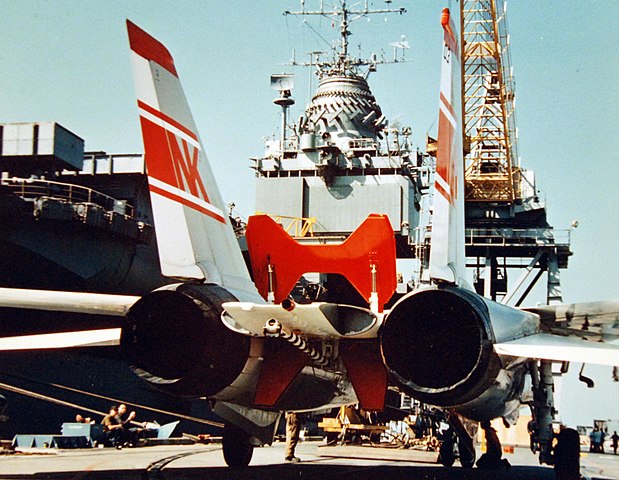
F-14A deployed in CVAN-65. She was the first carrier to operate these.
Upgrade history
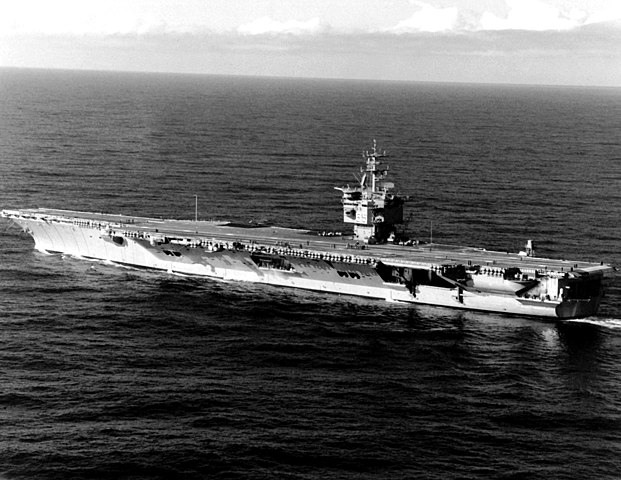
Post overhaul sea trials, off Washinghton, February 1982
Between November 1964 and July 1965 she had a complex overhaul, with her main mast raised and second yardarm added.
By June 1966-September 1966 out of Vietnam TOD, she had her waist catapult bridle catcher removed and two Mk-25 BPDM added.
In January 1969-March 1969 she was Repaired after the explosion and fire damage, but no addition was made.
In January 1979 to February 1982 she had her most complex Overhaul to date, with her mast replaced, ECM dome removed; SPS-32/33 arrays replaced with SPS-48/49 and 3 CIWS added. She was given a forward port sponson while her forward starboard one saw a Mk-29 added and for the aft port BPDM replaced with also with a Mk-29, plus the aft starboard BPDM removed.
In October 1990-September 1994 Second largest overhaul with core refueling and an aft boarding dock added.
In September 2004-October 2005 she saw RAM replacing Mk.29 CIWS at the forward port sponson and aft starboard sponson.
Misc. Facts
-Length of Ventilation: About 37 miles (60 kilometers)
-Length of Electrical Cables: About 625 miles (1005 kilometers)
-Water Distillation Plant Capacity: 350,000 gallons (1325000 liters / 1325 cubic meters) daily
-Number of Compartments: 3,500+
-Daily Meals Served Underway: 20,000+
-Services: General Store, 2 Gyms, 2 Barber Shops, Laundromat, Print Shop, Chapel, Library, Television Station and Studio, Coffee Shop, Daily Newspaper distributed underway
Gallery
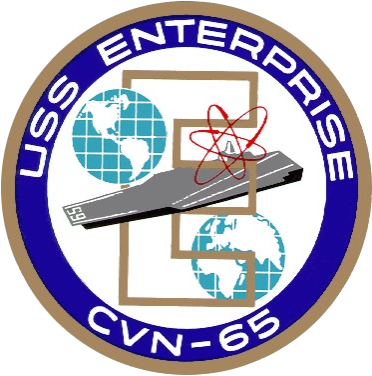
Coat of arms
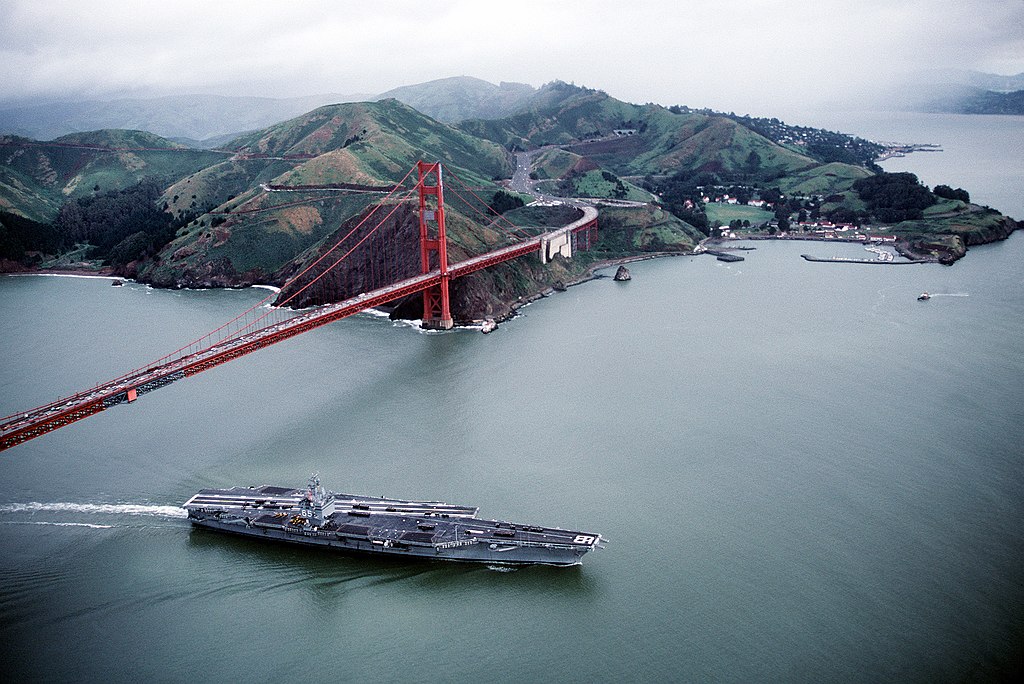
USS Enteprise under the Golden Gate bridge
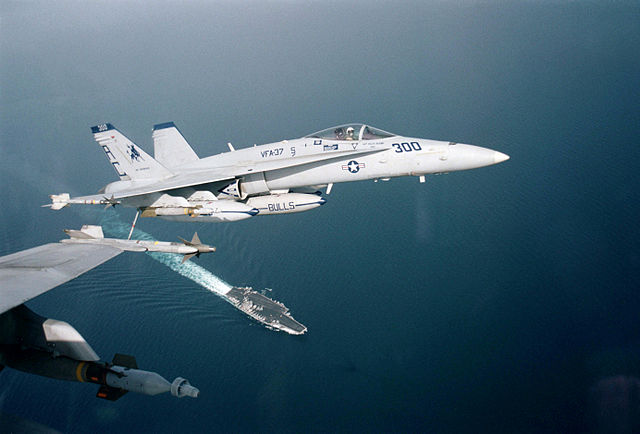
Defense.gov News Photo hornet on uss Enteprise
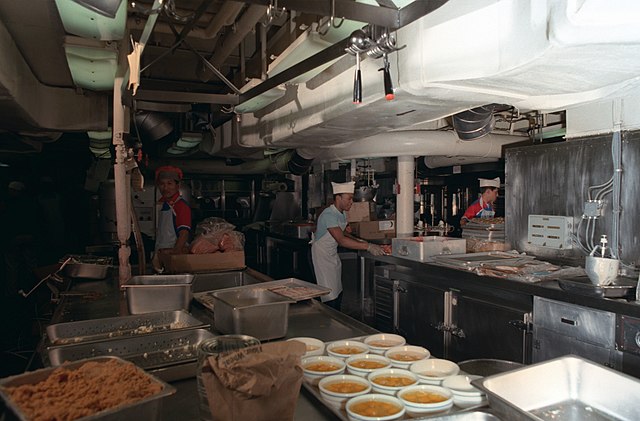
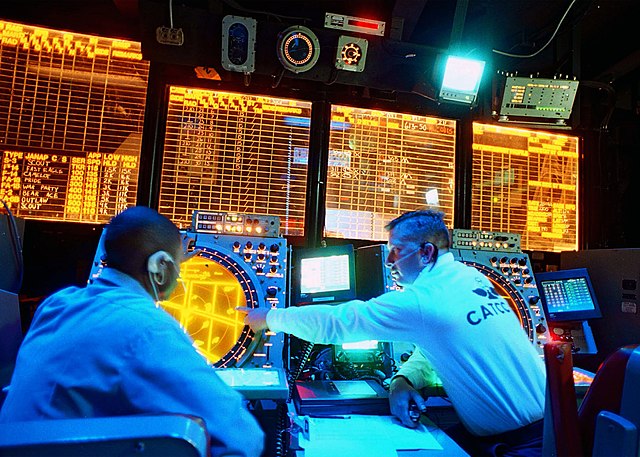
Evolution of US Carriers. Note the USS Enteprise is the longest, but not the widest (Reddit)

Author’s illustration of the USS Enterprise
⚙ specifications 1965/82/90 |
|
| Displacement | 71 277t 1965, 93,284 long tons Full Load 1990s |
| Dimensions | 1,088 x 132.8/257.2 x 39 ft (332 x 40.5/78.4 m x 12m) |
| Dimensions post refit | Same but 1,123 ft (342 m) long |
| Propulsion | 4 shafts Westinghouse turbines, eight A2W reactors 280 000 shp. |
| Speed | 33.6 kn (38.7 mph; 62.2 km/h) |
| Range | Unlimited, core change 20-25 yrs |
| Armament | None when commissioned, later Sea Sparrow, CIWS, RAM |
| Protection | 8-in aluminium belt, 4-in STS and later Kevlar, see notes |
| Sensors | Radar SPS-32, 33. |
| Aviation | 90 max, 60 normal Aircraft, see notes |
| Crew | 3325+1891+71 (Ship’ officers & ratings, air crew, Marines) |
*Height (Keel to Mast): 250 feet
An exceptional Career 1963-2012
Commissioning and trials
Commissioned on 25 November 1961 under command of Captain Vincent P. de Poix, in command, she prepared for her final sea trials and training, and from 12 January 1962 departed for her maiden voyage and extensive shakedown cruise with many tests and exercises all along to shape up the crew and determine her full capabilities. She was after all a nuclear-powered prototype. On 20 February 1962, she made her first “space mission”, by tracking Friendship 7’s (Project Mercury) space capsule flight, with Lt.Colonel John H. Glenn, Jr aboard in the first US orbital spaceflight. CVAN-65 came back at Naval Station Norfolk on 5 April 1962 for post-shakedown fixes.
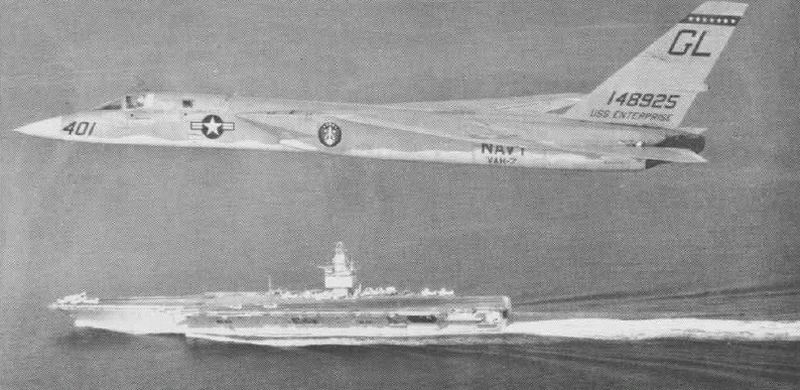
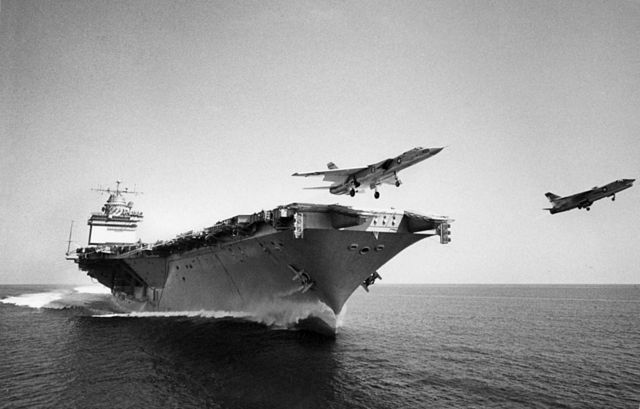
A3J-1 Vigilante of VAH-7 and F8U-1 being launched in 1962
On 25 June 1962, the new carrier started her active life, being asigned to 2nd Fleet for a first operational deployment, training off the US East Coast and taking part in LantFlex 2-62, a nuclear strike exercise with USS Forrestal (6–12 July). In August she joined the 6th Fleet for her first Mediterranean Sea deployment and was back in Norfolk, Virginia on 11 October 1962.
1962 Cuban Missile Crisis
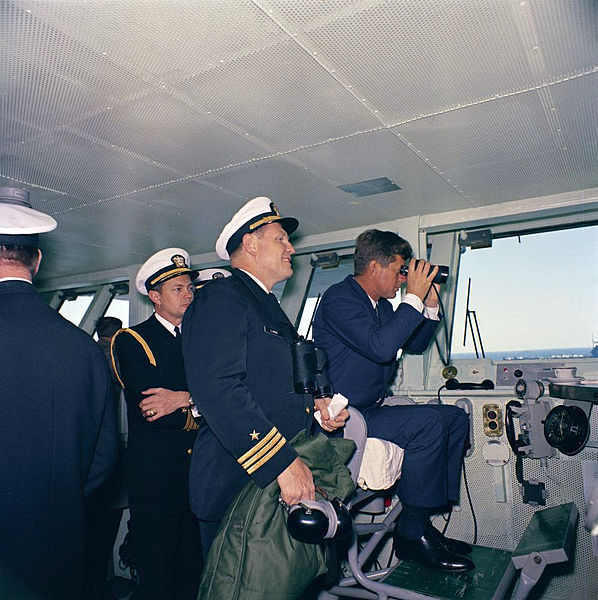
President Kennedy aboard USS Enterprise watching maneuvers in April 1962
In October 1962, the carrier saw her first international crisis deployment, following the revelations of Soviet nuclear missile launch sites on Cuba. As a response a large naval buildup was ordered by president JF Kennedy, with the Atlantic Fleet deployed in numbers, and from 22 October implementing the “quarantine” (blockade) of Cuba. 2nd Fleet carriers were grouped into Task Force 135, deployed to enforce it: USS Independence, Essex, Lake Champlain, , USS Enteprise and the crisis was defused on 28 October after tough negociations.
Mediterranean Service
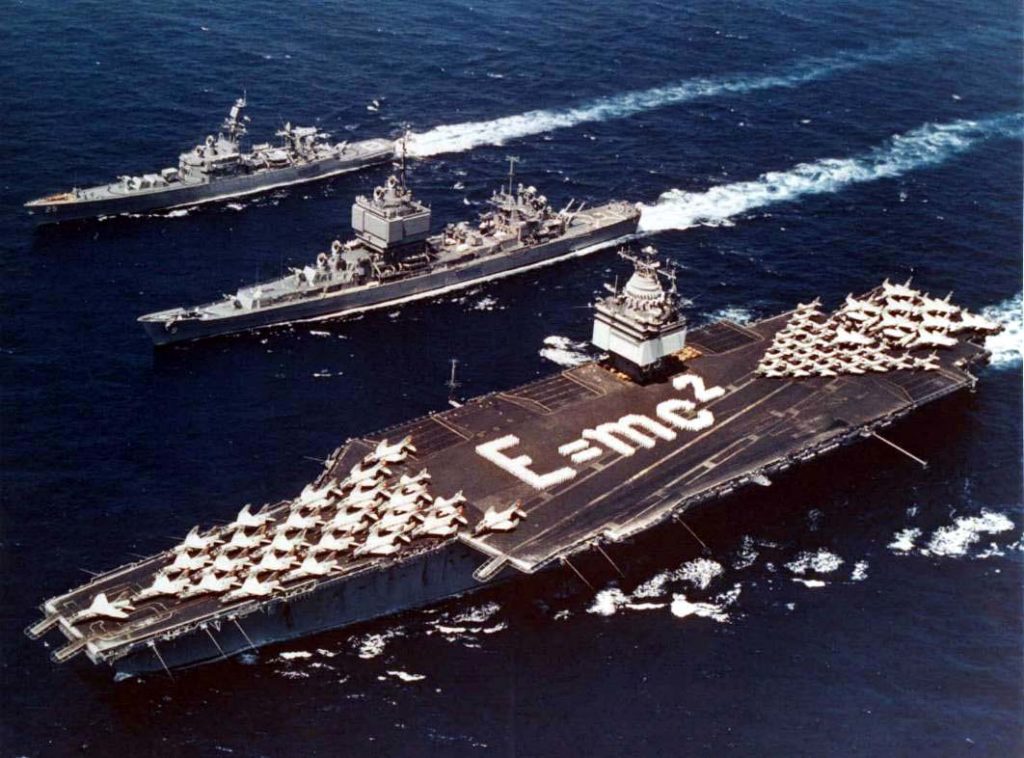
Task Force 1, the first nuclear-powered task force. Enterprise, Long Beach and Bainbridge in formation in the Mediterranean, 18 June 1964. Enterprise has Einstein’s mass–energy equivalence formula E=mc² spelled out on its flight deck. Note the distinctive phased array radars in the superstructures of Enterprise and Long Beach.
In 1963–1964, she was under command of Captain Frederick H. Michaelis for a second and third deployments in the Mediterranean. The third saw her taking part in Operation Sea Orbit (photo), the world’s first nuclear-powered task force, with USS Long Beach and Bainbridge. The concept was a replica of the early 1900s great white fleet, but with an all-nuclear task force sailing around the world, reassuring NATO and US allied nations.
On 25 February 1964, the carrier saved a sailor of the Finnish merchant ship Verna Paulin of Souda Bay in Greece, treated by a surgeon transferred by helicopter. In October 1964 she was back in Newport News for her first Refueling and Overhaul: All eight nuclear reactors already with 200,000 nmi (230,000 mi; 370,000 km) under their belt, were refuelled and two propeller shafts replaced. Electronics were also updated adn the process ended on 22 June 1965, in time for a first wartime deployment.
USS Enteprise in Vietnam
In November 1965, the nuclear carrier was transferred to the Pacific 7th Fleet, crossing Panama and reporting to NAS Alameda in California. On 2 December operation commenced against the Viet Cong near Biên Hòa City, as part of Carrier Division Three, operating Carrier Air Wing Nine (CVW-9) and escorted by the nuclear-powered cruiser USS Bainbridge and the missile destroyers USS Barry and Samuel B. Roberts. In total she performed 125 sorties the first day, dropping 167 short tons of ordinance on supply lines. On 3 December, she broke her record with 165 sorties.
1st deployment
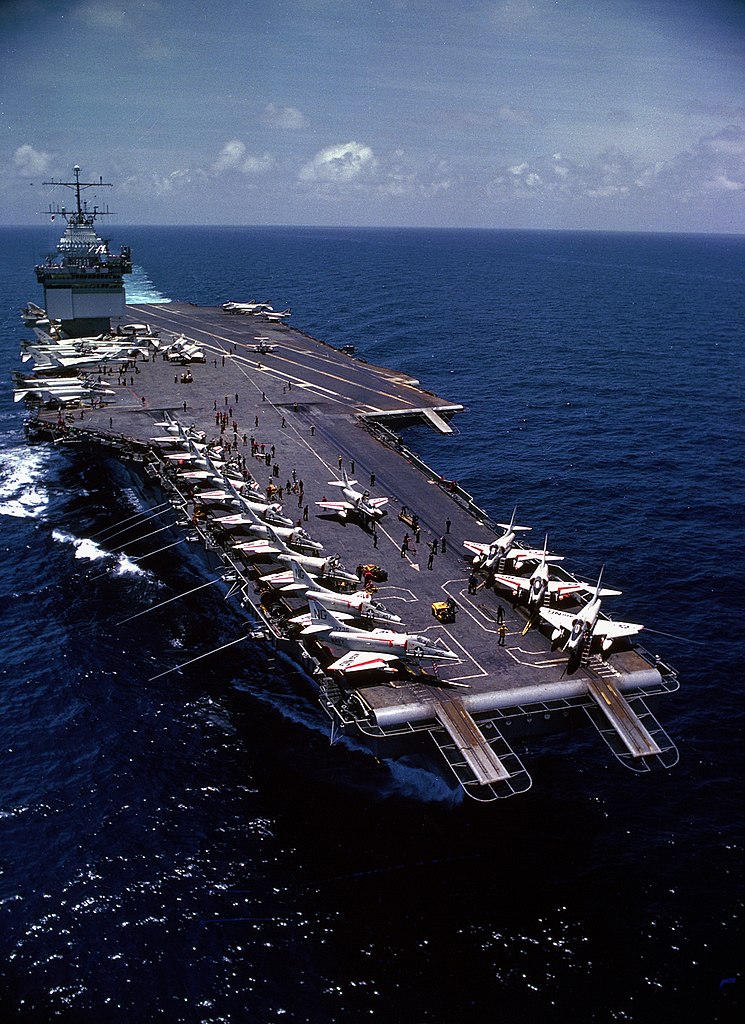
USS Enteprise in the Gulf of Tonkin, May 1966
In January 1966, as part of Task Force 77 deployed in the Gulf of Tonkin she was flagship of Rear Admiral Henry L. Miller, Commander Carrier Division 3 (CarDiv3) and had a new captain, James L. Holloway III, with 350 officers and 4,800 men aborad as the fleet’s HQ. CVW-9 deployed four squadrons under command of F. T. Brown, but also the fighter squadron VF-92 (E. A. Rawsthorne), VF-96, (R. D. Norman), VA-93 (A. J. Monger), VA-94 (O. E. Krueger), the firsts with Phantom II, the latter with A-4C Skyhawks. VA-36 (J. E. Marshall) and VA-76 (J. B. Linder) also depliyed the A-4C Skyhawk but RVAH-7 (K. Enny) deployed the RA-5C Vigilantes for high speed recce. RADM Miller was later relieved by RADM T. J. Walker on 16 February 1966 and he praised the ship’s performance, presenting air medals to 100 personal.
When USS Enteprise departed the Gulf of Tonkin on 20 June 1967 her air group totalled 13,400 battle missions in 132 days, over 67,630 miles. VADM Hyland praised also the ship, saying “the entire Air Wing Nine has earned a resounding ‘Well Done’.” She dropped anchor at Subic Bay on 22 June (Philippines) for resplenishment and crew’s leave. She departed on 25 June back to Alameda, arriving on 6 July.
2nd deployment
There, she started her overhaul as Captain James L. Holloway took command. When completed on 5 September 1967 she made her post-refit sea trials on 7 September, and sailed from San Francisco Bay to San Diego to take aboard CVW-9 and make her refresher training off the California coast before heading back for the Pacific and 7th fleet.
She stopped in Sasebo, Japan in January 1968 at the time USS Pueblo was seized by North Korea. There, she became flagship of TF 71 under Rear Admiral Epes in response to that serious incident, patrolling South Korean waters for a month (Operation Formation Star). Tensions decreased and USS Enterprise returned to Yankee Station on 16 February 1968. After a lighter sorties rythm, she was sent back to NAS Alameda on 18 July (she crancked up during this second Vietnam TOD some 12,246 sorties of which 9,182 were actual combat). She had a short overhaul in Puget Sound until 26 September and was back to Alameda, preparing her third deployment with the 7th Fleet in Vietnam.
USS Enterprise 1969 fire
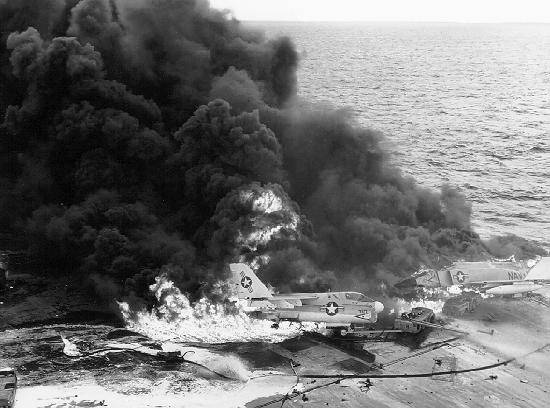
USS Entreprise 1969 accident
On the morning of 14 January 1969, while under escort of USS Benjamin Stoddert and Rogers, a short and cook off provoked ignition and launch of a MK-32 Zuni rocket, loaded on a parked F-4 Phantom being prepared for a sortie (as later shown by video deduced by the enquiry). The rocket flew straight into more stored ordnance and JP-5 filled tanks under other planes, making an explosion set off multiple fires and additional explosions across the flight deck. The hangar was spared, but it took some time to put the fires under control, much faster than on USS Forrestal in 1967.
In all, 27 sailors were KiA, 314 sailors injured, 15 aircraft had been destroyed, and the flight deck’s upper plating had buckled so much under heat no landong was possible. This force the carrier to sail off for repairs at Pearl Harbor NyD. All the plating was replaced and it was over on 1 March 1969, so she can resume her WESTPAC deployment at Yankee Station, in the Tonkin Gulf, delayed by what happened in the eastern Sea of Japan.
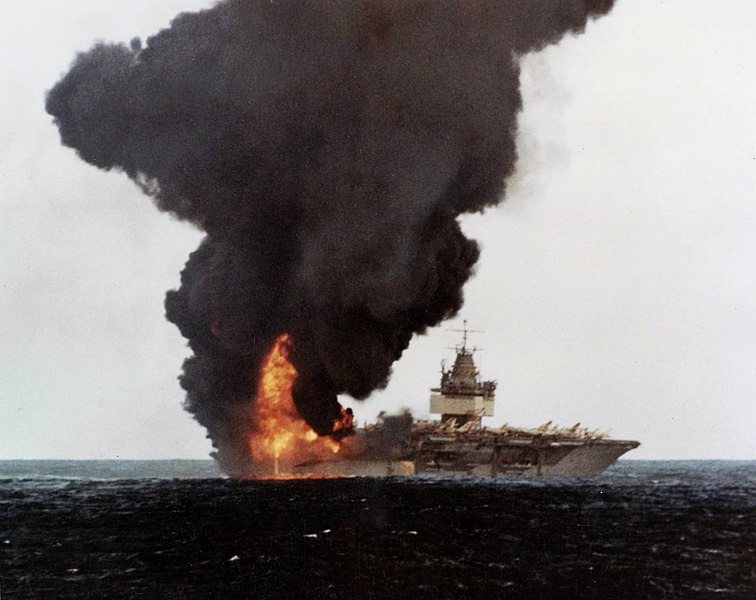
CVAN-65 burning, stern view
Indeed, on 14 April 1969, tensions with North Korea took a new height when a North Korean jet deliverately shot down a Lockheed EC-121 Warning Star patrolling over the eastern Sea of Japan from Atsugi base in Japan. Task Force 71 was reactivated in response, deploying air groups to patrol these international waters. Enterprise joined later USS Ticonderoga, Ranger, and Hornet and their escorts. She arrived by late April and took part in the largest show of force in the area since 1952.
4th-5th Vietnam deployments
In 1969–1970, CVN-65 was back in Newport News Shipbuilding for a long overhaul and refitting, with post-refit sea trials completed by January 1971, having new nuclear reactor cores setup to last 10 years. On 11 June 1971 under command of her new captain, Forrest S. Petersen she received CVW-14 onboard for her fourth deploymeny in Vietnam.
There, she joined USS Oriskany and Midway and together they launched 2,001 strike sorties up to 30 July 1971. They had to leave the area three times to flee the typhoons Harriet, Kim and Jean. These were visual strikes on enemy troop positions combined with helicopter operations. On August–November 1971 Enterprise operated from Yankee Station and by December 1971 changed command with Captain Ernest E. Tissot, while she sailed in the Bay of Bengal as the Indo-Pakistani War of 1971 developed. This was a deployment turned against India’s naval blockade on Pakistan from INS Vikrant, complicated by the presence of a Soviet submarine trailing the task force. USS Enterprise then returned to Southeast Asia to avoid escalation in the area. He last leg for this 4th deployment ended on 12 february 1972.
6th Vietnam deployment
She made a 6th deployment, this time in the South China Sea from 12 September 1972 with CVW-14 onboard and on 18 December she resumed bombing sorties beyond the 20th parallel as part of Operation Linebacker II with other carriers on station. They also laid minefields in Haiphong harbor and tried to protect USAF bombers by dealing with SAM and AA sites. They also targeted artillery positions and barracks, but also infrastructure plus the Haiphong naval Bas itself, denying the North Vietnamese Fleet any sortie.
These tactical air attack sorties concentrated moslty on the coastal areas (notably Hanoi and Haiphong) leaving the USAAF dealing with more inland objectives. 705 Navy sorties were performed by USS Enteprise and but operations were hampered by bad weather. By December 1972, Linebacker II was terminated and on January 1973 cease-fire was announced. On 28 January there were only 81 combat sorties over Laos and the Ho-Chi-Minh trail. They were forced to fly in a narrow corridor to get there, between Huế and Da Nang. The Laotian government requested this assistance, not having signed a ceasefire. This went on until 12 June 1973 and the carrier returned home.
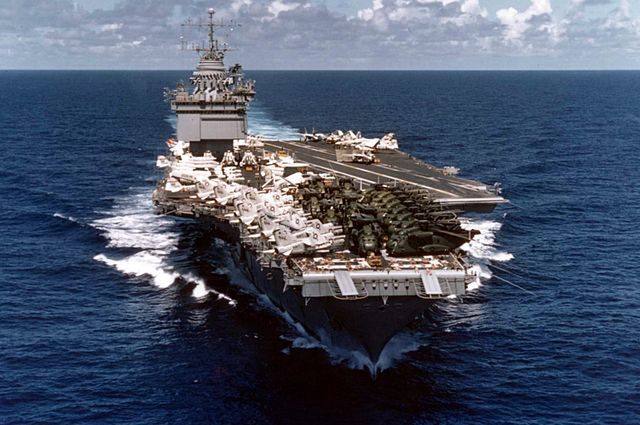
CVAN-65 returning from Hanoi, Vietnam 1975.
Back Home (1973-75)
USS Enterprise arrived for a refit and overhaul at Puget Sound Naval Shipyard in Bremerton (Washington, North Pacific coast) most of which was dedicated to the arrival of the latest USN fighter, the Grumman F-14 Tomcat. Two jet blast deflectors were enlarged notably. One shaft was also replaced, bent after a discarded arresting gear cable was caught by the propeller.
On 18 March 1974, Tomcats from VF-1 Wolfpack and VF-2 Bounty Hunters arrived for carrier qualifications and by September she was the first carrier to deploy tomcats for her 7th WESTPAC.
Before arrival, on February 1975 she was detached for humanitarian assistance of Mauritius, badly hit by Typhoon Gervaise, providing disaster relief from Port Louis. Personal from the carrier helped restoring water, power, telephone, clearing roads, provided medical, food and drinkable water.
Operation Frequent Wind (1975)
In April 1975 she departed for a massive deployment with USS Midway, Coral Sea, Hancock and Okinawa off South Vietnam, this time loaded with helicopters to provide evacuation of personal as North Vietnam launched a new, unstoppable invasion. Soon, on 29 April, Saigon was under direct attack, and Operation Frequent Wind was was started, with U.S. Marine Corps helicopters, evacuating American citizens and collaborating Vietnamese personal from Saigon, until the city fell.
This operation was ordered by President Gerald Ford after aviation evacuation from Tan Son Nhut Airport was precluded by North Vietnamese shelling. Helicopters operated under constant fighter cover and they notably landed at the US Embassy and in a DAO Compound, picking up evacuees in such numbers that extra space had to be found when returned. The last helicopter famously left the roof of the embassy at 7:53 am on 30 April, with the rearguard defending 11 Marine Security Guards. VF-1 and VF-2 flew 92 sorties, the first by the F-14 Tomcat.
Post-Vietnam Service
8-9th WESTPAC deployments
In July 1976, USS Enteprise departed home (Alameda) for her 8th deployment in the Pacific, and in October, took part in exercise Kangaroo II with the ANZUS, Australian and New Zealand Navies vessels. She also for the first time visited Hobart in Tasmania in November 1976. By February 1977 there was a new crisis as Idi Amin (Uganda) tool US Citizens as hostages several months after the Israeli raid at Entebbe airport. USS Enterprise called Mombasa back for Asia, and were redirected off the east African coast, staying there to “how the stick” for about a week. The Marine detachment were prepared for a possible rescue mission and evacuation, until Amin released all hostages. She then departed for the Indian Ocean and dropped anchor at NAS Cubi Point, Philippines and steamed back home to NAS Alameda.
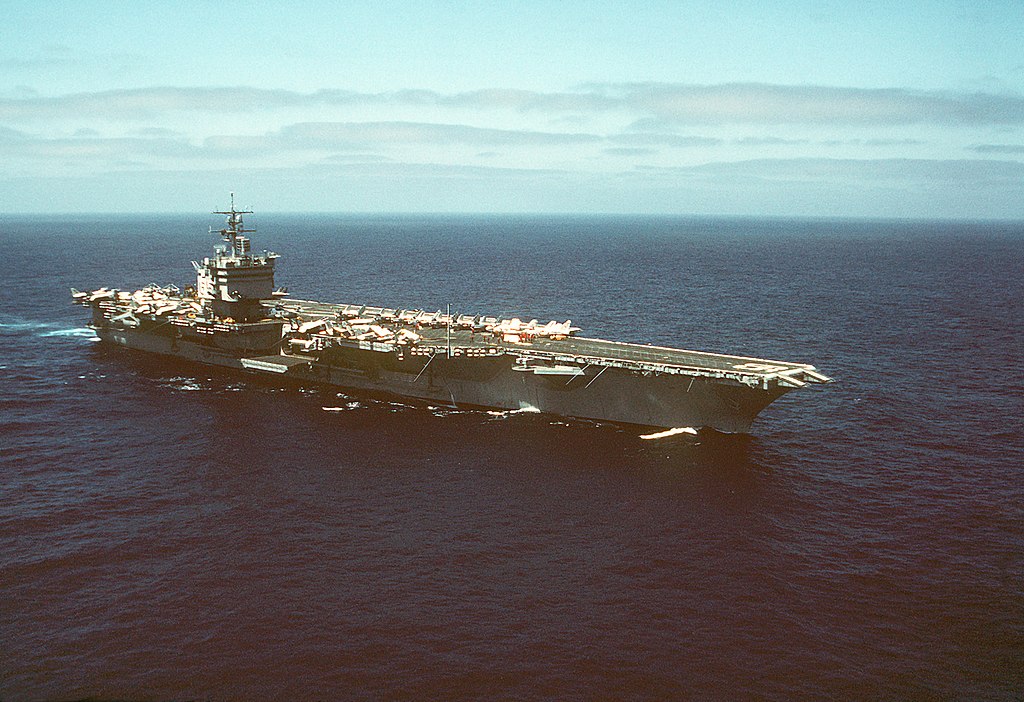
USS Enteprise post overhaul service, 1st November 1982
In 1978, she started her 9th WESTPAC deployment, stopping at Hong Kong, Perth, and Singapore. She was back home in December and by January 1979, she was sent into Puget Sound for a major overhault, over 36-month which notabl consisted in removing her SCANFAR radars and cone and making many more modifications. This all ended in 1982.
10th WESTPAC deployment
In 1982, after post-refit sea trials and a refresher crew, receiving her new air group, USS Enteprise departed 10th WESTPAC, without issue. But while back home in April 1983 she ran aground on a sandbar, in San Francisco Bay, being stuck there for several hours. Robert J. Kelly was in command at the time, later a 4-star admiral, CinC U.S. Pacific Fleet, managed the issue quite well at the time. Later in 1983, USS Enterprise was deployed with USS Coral Sea and Midway off Alaska for FLEETEX 83 exercise.
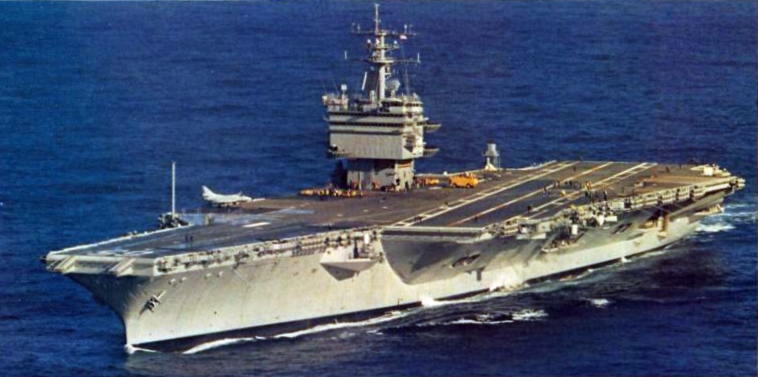
CVN-65 after refit in 1982
11-12th WESTPAC deployments
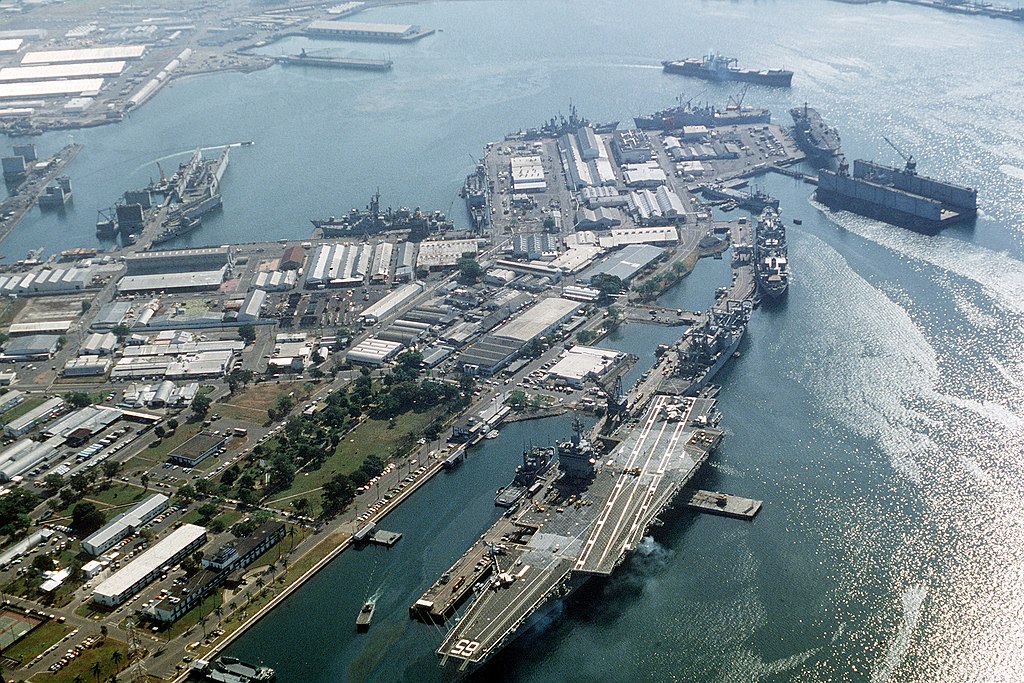
USS Enteprise in Subic Bay, 1986
In 1985 her 11th Pacific deployment started, until late at night on 2 November 1985 (with Captain Robert L. Leuschner, Jr. in command), she struck Bishop Rock, Cortes Bank, badly damaging the outer hull. The rock created a gash 100 ft long. The repairing cost was $17 million while Leuschner was relieved of command on 27 January 1986, replaced by Captain Robert J. Spane. For the first time she received the FA-18 Hornet in partial replacement of her Tomcats (she kept both for about a decade).
In 1986 she made her 12th WESTPAC from 15 January 1986, leading Battle Group FOXTROT (Truxtun, Arkansas, O’Brien, Reasoner, Lewis B. Puller, McClusky, David R. Ray, Wabash) into the Indian Ocean and stopping at Hawaii in Subic Bay and in Singapore along the way, and by 28 April 1986, USS Enterprise entered the Suez Canal, first nuclear carrier to do so.
She went through the Red Sea and entered the Mediterranean to relieve USS Coral Sea on station off the coast of Libya during a new crisis. She teh took part in Operation El Dorado Canyon, the aerial reprisal bombing of Libya. RADM J.T. Howe replaced during this operation by RADM Paul David Miller.
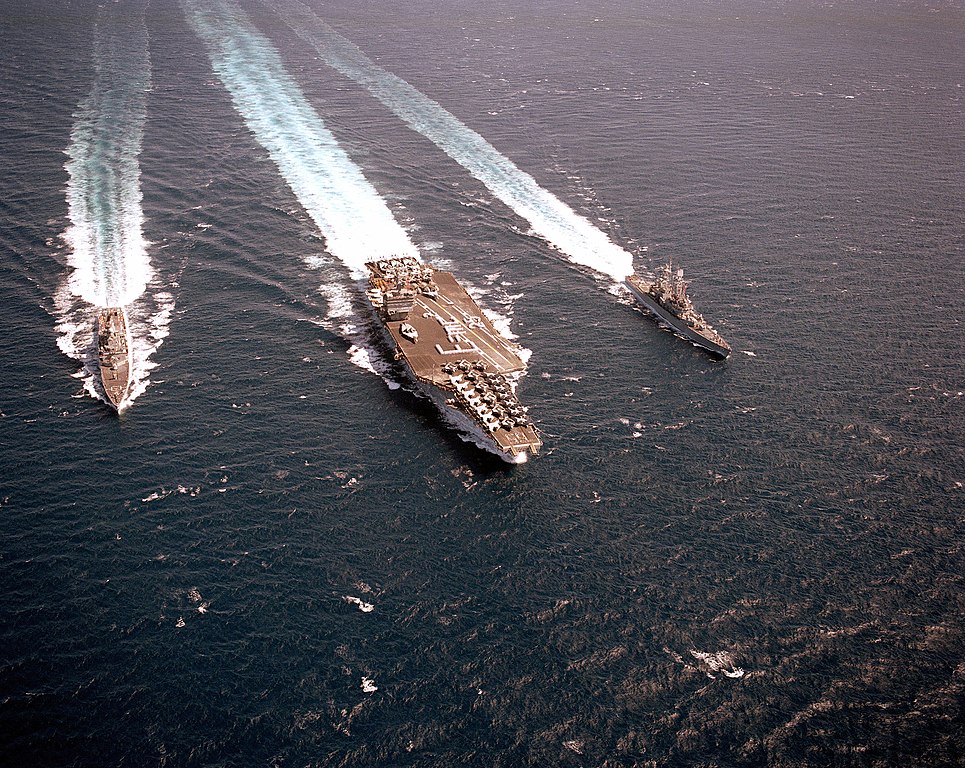
USS Enterprise, USS Truxtun, USS Arkansas underway in the Pacific Ocean on 17 September 1986
3rd MED deployment
In February 1988, she started her 13th deployment, again from the east coast and via the Indian Ocean, assigned to Operation Earnest Will. She was assigned to the 7th fleet ship and sailed from Alameda NAS to Gonzo Station in the North Arabian Sea. The goal was to escorting reflagged Kuwaiti oil tankers in the Persian Gulf, under Iranian threat. On 14 April Samuel B. Roberts struck an Iranian mine in international waters and Operation Praying Mantis followed, with multiple USN strikes against Iranian targets, notably Iranian oil platforms used as support bases for merchant shipping attacks. CVW-11 also destroyed two Iranian frigates, one sink, the other damaged beyond repairs while providing air support and cover.

In September 1989 “Big E” started her 14th deployment, this time an around-the-world cruise supposed to end at Naval Station Norfolk, Virginia, West Coast. In December 1989, she took part with USS Midway to Operation Classic Resolve under the Bush administration, in response to Philippine President Corazon Aquino’s request for support during a rebel coup attempt. The carrier remained in Manila Bay until the end of the crisis.
The 1990s
In April 1990, USS Enterprise had completed her world-spanning deployment and as planned entered Norfolk in Virginia with 43,000 mi (69,000 km) under her belt. By October, she entered Newport News for refueling her nuclear cores and her largest and complex overhaul to date. It ended on 27 September 1994, and she sailed for sea trials with Captain Richard J. Naughton in command. She proved she can reach the same speed, or even exceed the speed she had during her 1961 sea trials. This refit deprived her of eny participation into the 1991 Gulf War.
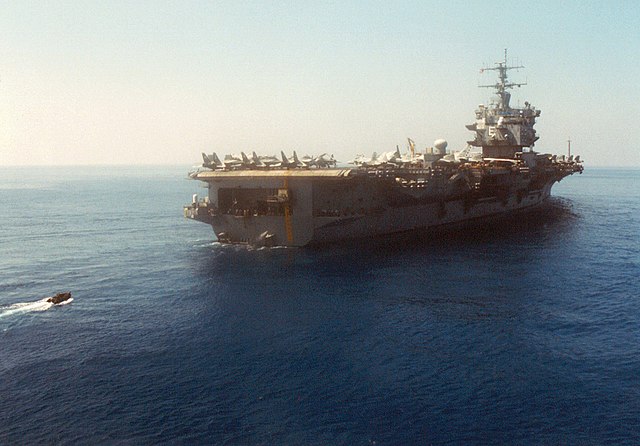
SEALs training in close security around USS Enteprise, Mediterranean 24 August 1996.
On 28 June 1996, she departed for a 15th deployment, this time off the Balkans in the Mediterranean: She was to create a no-fly zone in Bosnia (Operation Joint Endeavor) and later, she ws relieved and went to the rea sea to participate in Operation Southern Watch over Iraq, until December 1996. By February 1997 back home, she entered Newport News for her first “selective restrictive availability” over 4.5 months, and skeleton crew.
By November 1998 she made her 16th deployment with CVW-3 onboard. In the night of 8 November, a Northrop Grumman EA-6B Prowler crashed into a Lockheed S-3 Viking when landing during night carrier qualifications. The problem was caused by the S-3 not yet clearing the landing area in time. Only the S-3 could be repaired later. The entire crew of the EA-6B died as it went overboard and crashed on water, while the two pilots of the S-3 ejected in time and only had injuries. The spilled JP-5 caused a major deck fire, quickly extinguished by the crews.
On 23 November 1998, USS Enterprise arrived on station in the Persian Gulf to relieve the Nimitz class USS Dwight D. Eisenhower. She made a call at Jebel Ali in the UAE, and hosted there former President George H. W. Bush (a former USN WW2 aviator) for a live concert by Hootie & the Blowfish.
In December 1998 she “led the pack” for Operation Desert Fox: Her air group struck Iraqi military targets in complement of 300 Tomahawk missiles, delivering 691,000 lb (346 short tons) of ordnance during the 70-hour assault, assisted by her escort USS Gettysburg, Stout, Nicholson and Miami.
She was back off the Balkans and visited Cannes, southern France after the Račak massacre and Rambouillet Peace talks failure. She was back later in the Adriatic. In March 1999 she returned in the Persian Gulf, relieving USS Carl Vinson for Operation Southern Watch and was back in Norfolk by May 1999. During this deployment she covered 50,000 nmi (93,000 km or 58,000 mi) with 151 days at sea and underway. USS Enterprise’s Battle Group inaugurate the IT-21 external and internal communication system using Satellite, Internet, email, and television.
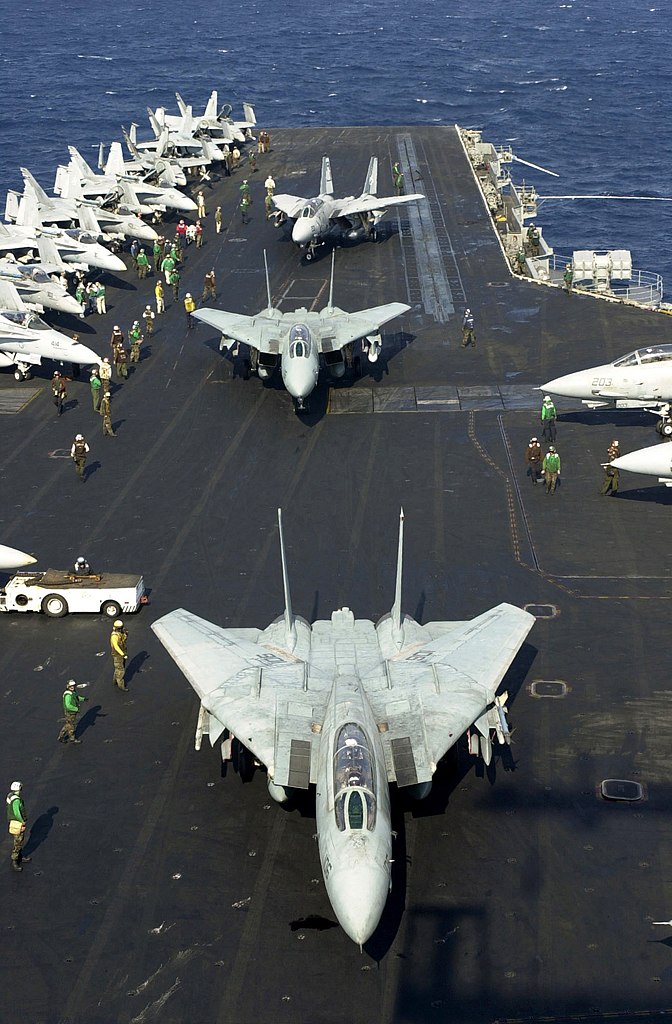
Byn March 2001, USS Enterprise took part JTFEX 01-2 in the Caribbean Sea, during which the Bundesmarine deployed U24 (Type 206) which famously managed to approach and “sink” USS Enterprise with a photograph through periscope as proof, then surfacing to launch flares. This prompted some reaction after recent developments in diesel submarine acoustic evasion. On 25 April 2001, USS Enterprise made her 17th deployment with CVW-8 on boar and under command of Captain James A. Winnefeld, Jr. On 18–28 June she took part in an exercize with the Royal Navy in the North Sea, off the Hebrides Islands and Scotland.
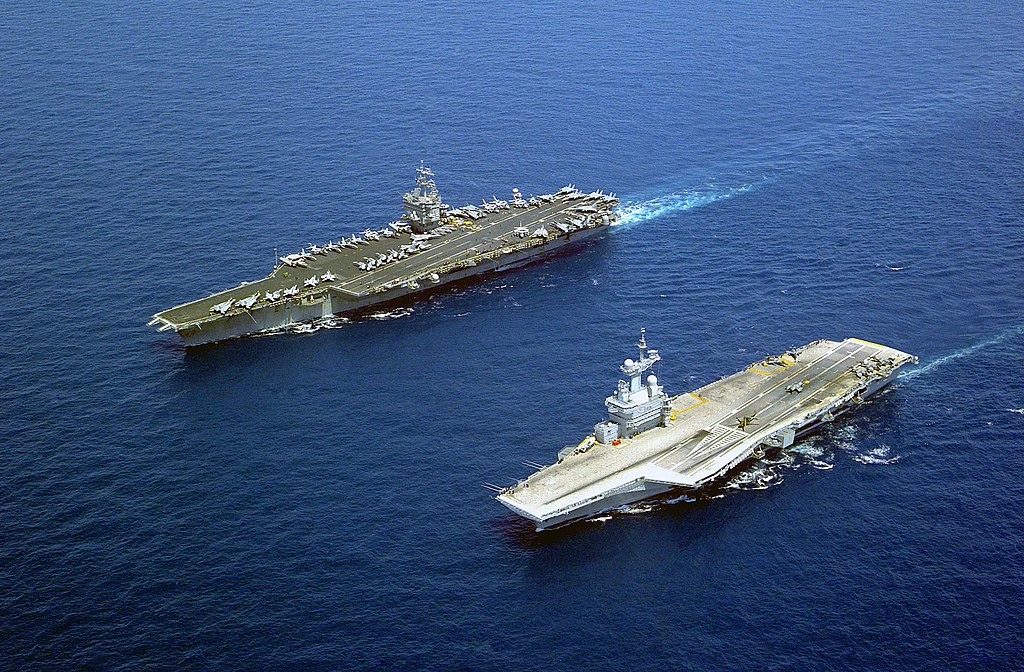
Next, she sailed in emergency after hearing news of the September 11 attacks, without orders via Southwest Asia even outrunning her escorts to the Persian Gulf. In October 2001 air attacks started against Al-Qaeda camps and Taliban installations throughout Afghanistan. For three weeks her air group flew close to 700 missions, spending 800,000 lb (360 t) of ordnance. On 10 November, she was back in Norfolk, after hosting a live two-hour broadcast of ABC’s Good Morning America. On Pearl Harbor Day she hosted President George W. Bush which addressed sailors from the flight deck.
In January 2002, she made a year long overhaul in Norfolk Naval Shipyard and Selected Restricted Availability period.
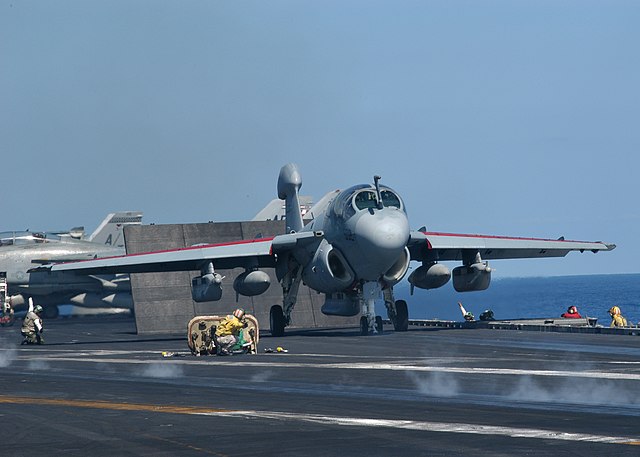
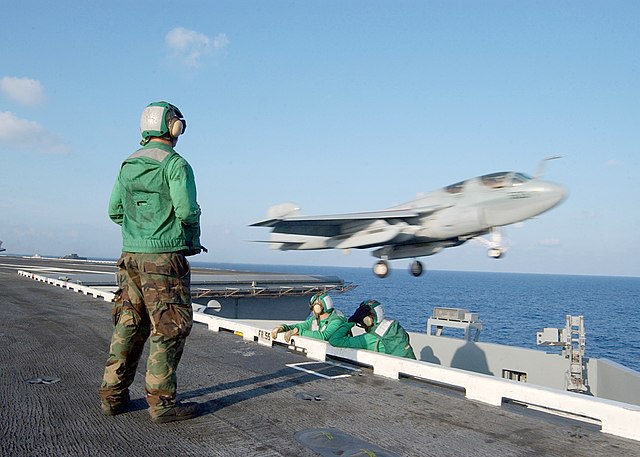
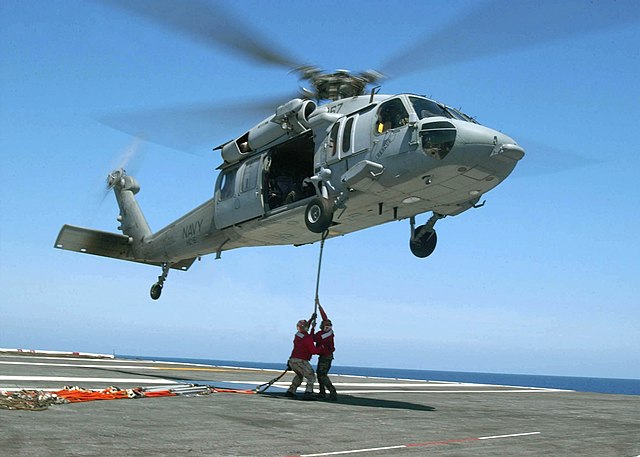
Iraq War
From September 2003 (Until February 2004), under command of Captain Eric Neidlinger she was deployed to relieve one of the four carriers on station during the invasion, with Admiral James Stavridis commanding the battle group. Her air group reflected her role, to provide air support (mostly air cover) for Operation Iraqi Freedom. She carried only F/A 18 Hornet fighters, no attack plane, escorted by USS Cole. She was also touring with some personalities on board giving talks and performances. She stopped on the way home in Jebel Ali (Bahrain), Naples, and Cartegna.
USS Enterprise Sailors became TV celebrities during the Paramount Television series “Enterprise” presetning the ship in 2003.
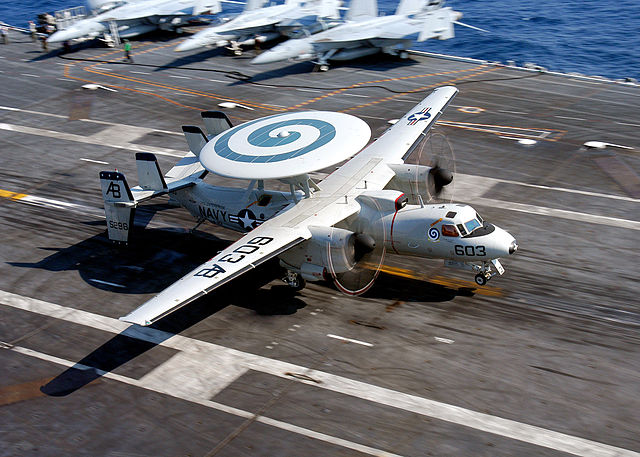
E-2C from VAW-123 in 2005
In 2005, she made a short shipyard overhaul at Newport News but while making her yard sea trials she hit a sand bar: All her eight reactors were shut down by the shock and she started to go adrift on emergency power for three hours. Tugs caught her and she was brought back to Norfolk Naval Base while nuclear machinists clearned her condensers. In May 2006, she sailed for another deployment, of six months, in a “world tour”, visiting the 6th, 5th and 7th Fleet, between Operations Iraqi/Enduring Freedom, stopping en route to Dubai and Hong Kong, and back to Norfolk on 18 November 2006. On 19 December 2007, she made a thord deployment, again of six month to the Persian Gulf.
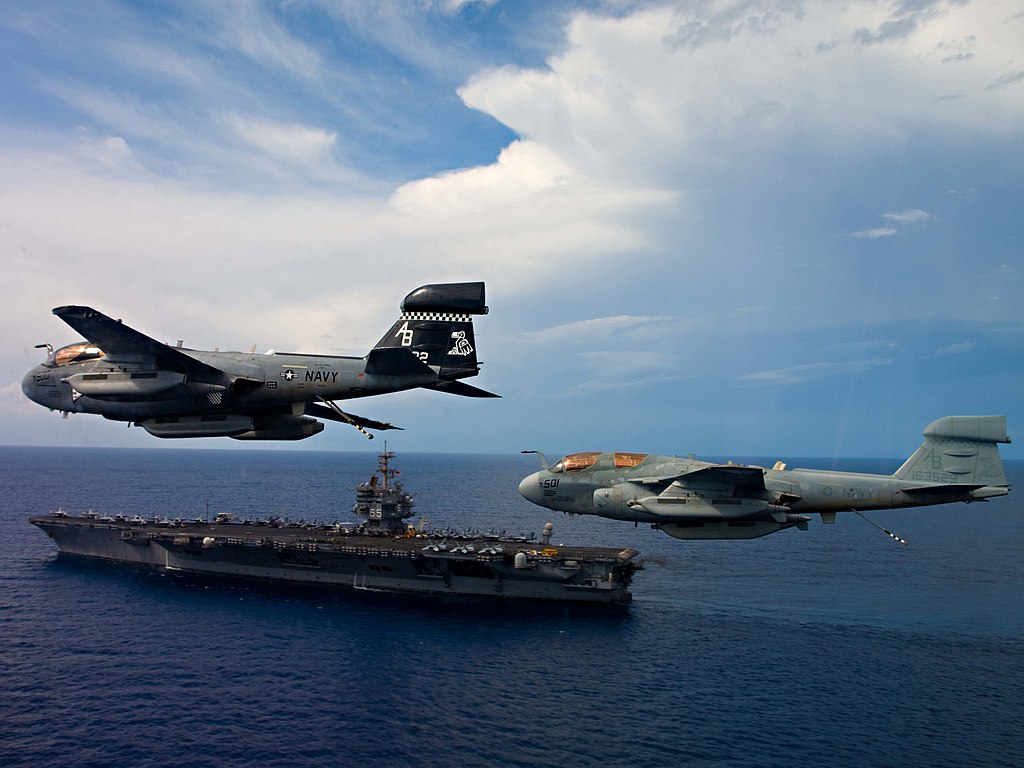
“Big E” last overhaul (2008-2009)
In April 2008, she entered Newport News shipyard (now part of Northrop-Grumman) for her last major overhaul, lasting 18-month and her “Extended Docking Selected Restricted Availability”; It was secheduled to end in September 2009. Maintenance was done but as the number of elements to replace made costs rising fast, well above projections, the Navy place a decommission date to 2014 for the veteran of USN Carriers. On 6 April 2009 CNO Admiral Gary Roughead announced he would obtain a faster decommission through congressional approval, so the overhaul was completed for just a final deployment. Thus, the Navy planned to have “only” ten active aircraft carriers until the Gerald R. Ford was expected to be launched in 2015. In October 2009, Public Committees agreed with the recommendation and the decommission was programmed for 2013, with still made for a symbolic, staggering 51 years of service…
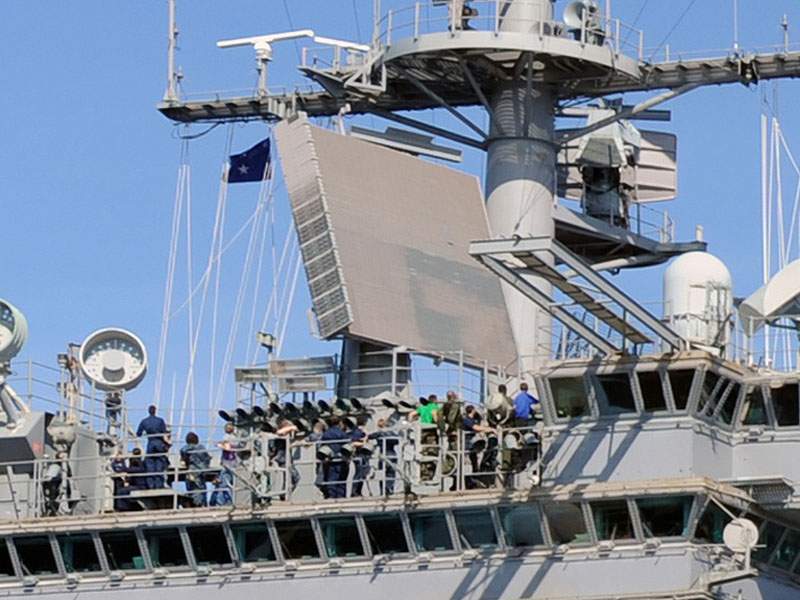
SPS-48 Radar in 2010
Last deployment and decommission (2009-2013)
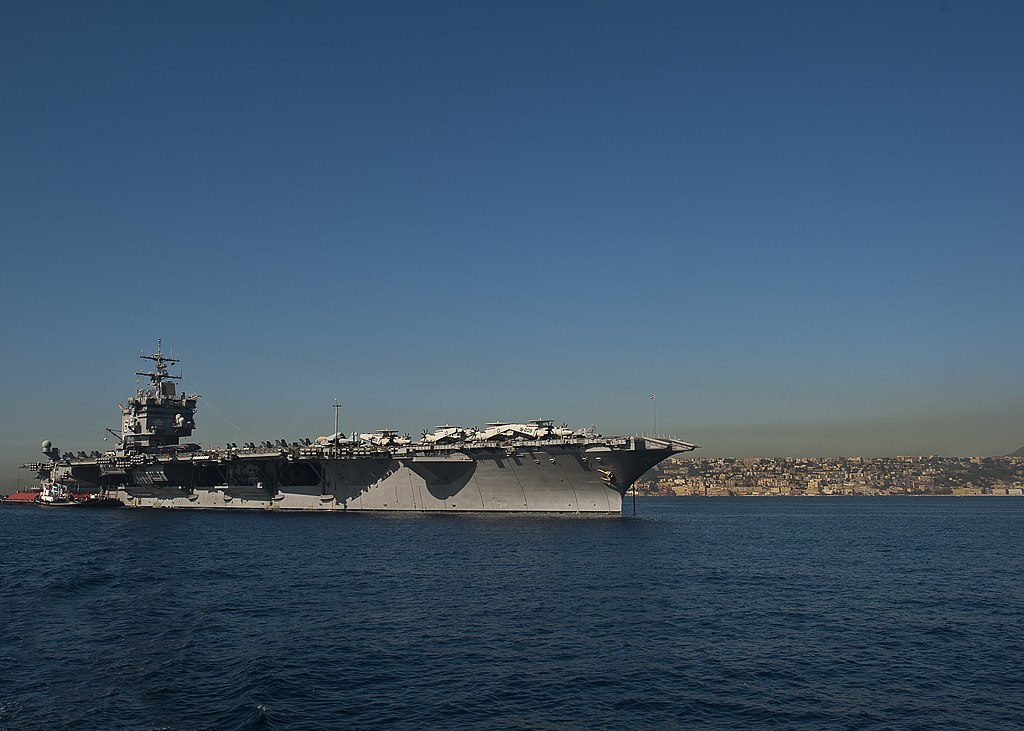
USS Enterprise anchored off Naples on her last deployment
After a cost of $662 million (46% over budget, 8 months more than planned) completion of the overhaul was achieved and she was ready for her last deployment, sailing out the yard on 19 April 2010, making her post-refit sea trials . The Navy announced two yearly six-month deployments before her 2013 decommission. But before the first started in January 2011, she took part in an internal movie by the current XO, Captain Owen Honors, in “XO Movie Night”, that was leaked publicly and caused some stir in the press by its content. On 4 January 2011, Admiral John C. Harvey, Jr. blamed him despite of the crew’s support. Captain Dee Mewbourne became her new XO and in the wake of the scandal some 40 officers ratings were disciplined.
At last on 13 January 2011 she departed with Air Wing One aboard escorted by the Ticonderoga class guided-missile cruiser USS Leyte Gulf, and the Burke class USS Barry, Bulkeley, and Mason. In February 2011, she was involved in a rescue of US citizens captured by Somali pirates.
Back to Norfolk on 15 July she retured with 75 Somali pirates aboard, also participating in the bombing raids over Libya. On 17 August 2011, Captain William C. Hamilton, Jr. too command, and she was prepared in March the next year for her last deployment, joining off Norfolk the escorts of her Carrier Group, USS Vicksburg, Porter, Nitze and James E. Williams. On 9 April 2012 this was named Carrier Strike Group 12, assigned to join USS Abraham Lincoln in the Persian Gulf. In October 2012 she crossed the Suez Canal for the last time, and visited Naples on 16–21 October to close a long 50-years loop since her service start. The city was indeed her very first foreign port call.
On 4 November 2012 she was back at Naval Station Norfolk in Virginia, having cranked up some 81,000 miles, 238-day at sea in the Persian Gulf, 2,000 sorties for Operation Enduring Freedom in Afghanistan.
Decommissioning
Deactivation started on 1 December 2012 at NAS Norfolk at a cost of $857.3 million in depot maintenance FY2013. As the first US nuclear-powered aircraft carrier decommissioned many questions were in the air. Between her name and exceptional service, plus historical significance, it was not long before many asked for her preservation as a museum ship. However it was soon objectd as way too expensive, given she was to be denuclearized first. A petition also called for the next carrier to be named as the USS Enterprise, but it was not to pass. The Gerald Ford class following ship was named JF Kennedy but indeed the third, CVN-80, laid down on 5 April 2022 for an expected launch on November 2025 as scheduled will indeed become the 9th of the name.
In 2013, Enterprise, considerably lightened, without mast, was towed to Newport News for the complex operation of de-fueling her reactors before being properly broken up.
On 8 February 2013, the DoD announced that postponements of several operations, including the planned de-fuelling of USS Enteprise amidst budget sequestration. But this also concerned mid-life overhauls for two Nimitz-class carriers, and the contract was eventually awarded to Huntington Ingalls Industries, by June. By October 2014 the carrier anchors were transferred to the Nimitz-class USS Abraham Lincoln. In early 2017, CVN-65’s material was announced to be reused to built CVN-80, the new USS Enteprise, and this represented 35,000 pounds of steel. Former crewmen and officers also created a time capsule using her steel and wood to preserve her history for USS CVN-80.
CVN-65’s final reactor was defueled in December 2016 and full decommission was acted on 3 February 2017 (there was a ceremony before) and she was stricken from the Naval Vessel Registry. Recycling was delayed as were discussed “environmentally responsible” approaches. On 10 April 2018, Newport News announced the inactivation complete and she was towed to Hampton Roads for disposal.
In 2019 as planned one of her anchors was transferred USS George Washington (CVN-73) while refitting at Newport News.
Current status:
The ship still exists today, and due to limited capcity her recycling still has not been done (and delayed by COVID). By mid-2022 Newport News Shipbuilding won an $11 million contract to store the vessel until September 2024, pending further decision. It seems the wishes of those who wants to preserve her are not completely hopeless, but chances she is converted as a museum ship are very slim to say the least, owing the new policy of recycling ships, and complicated by her nuclear-powered status and contamination. USS Long Beach for example as of May 2018 had her inactivated hull and reactor compartments remaining in long-term storage, whereas USS Nautilus was granted the status of Museum Ship.
Read More
Books
Blackman, Raymond V. B., ed. (1971), Jane’s Fighting Ships 1971–72, Jane’s
Cracknell, W. H. (1972), Warship Profile 15: USS Enterprise (CVAN 65) Nuclear Attack Carrier, Windsor Profile Publications
Friedman, Norman (1983), U.S. Aircraft Carriers: An Illustrated Design History, Anapolis NIP
Gardiner, Robert; Chumbley, Stephen, eds. (1995), Conway’s All the World’s Fighting Ships 1947–1995
Polmar, Norman (1981), The Ships and Aircraft of the U.S. Fleet (Twelfth ed.) Arms and Armour Press
United States Naval Aviation, 1910–1995, Naval Historical Center
USS Enterprise (CVN 65) public affairs office
Links
https://eu.kitsapsun.com/story/news/2022/08/19/navy-wont-scrap-former-enterprise-aircraft-carrier-puget-sound/7845512001/
https://www.thedrive.com/the-war-zone/27755/parts-from-the-retired-uss-enterprise-are-keeping-her-successors-ready-for-combat
https://commons.wikimedia.org/wiki/Category:General_views_of_USS_Enterprise_(CVN-65)
https://www.seaforces.org/usnships/cvn/CVN-65-USS-Enterprise.htm
https://www.seaforces.org/usnships/cvn/CVN-65-USS-Enterprise-history.htm
https://web.archive.org/web/20150117120258/http://www.enterprise.navy.mil/
https://web.archive.org/web/20130516113455/http://www.navy.mil/local/story_archive.asp?id=7
https://web.archive.org/web/20150427235754/http://www.mooj.com/rxdept.htm
https://cvan-cvn-65.org/
https://www.navysite.de/cvn/cvn65.html
http://www.uscarriers.net/cvn65history.htm
https://web.archive.org/web/20191225073002/https://www.navypedia.org/ships/usa/us_cv_enterprise.htm
https://www.carrierdisposaleis.com/
https://en.wikipedia.org/wiki/Naval_Reactors
https://www.jag.navy.mil/library/investigations/BASIC%20FIRE%20ON%20USS%20ENTERPRISE%2014%20JAN%201969.pdf
https://apps.dtic.mil/sti/pdfs/ADA429103.pdf
Videos
Flight Deck Operations USS Enterprise (CVN-65) – Airboyd
Flight operations compilation by Ultimate Military Channel
Visit of USS Enteprise, Pt.1 by Liveboat USA
Model Kits
A well-beloved topic. General Query on scalemates. Amazingly, there was a 1:72 model, by Uschi van der Rosten. The usual scale is 1:350, by Mini Hobby and Tamiya, Trumpeter, but also a 1:390 by Ideal Toy Corporation, 1:400 by ARII, Aurora, CC Lee, LIFE-LIKE Hobby Kits, Nippon Hobby, Monogram, Otaki, Paramount, Revell, and more rare Nichimo 1:500, ITC – Ideal Toy Corporation (ITC) 1:556, ARII/Avademy/Kangnam 1:600 the unique Cyber Hobby 1:700 and Revell 1:720, a few to 1:800 and below at 1:1140, 2000, and tons of accessories, in particular for the 1:350 (vehicles, details, personal, markings etc).
Review on modelshipgallery.com/
1:350 kit in detail by Jorge Evandro (Br)

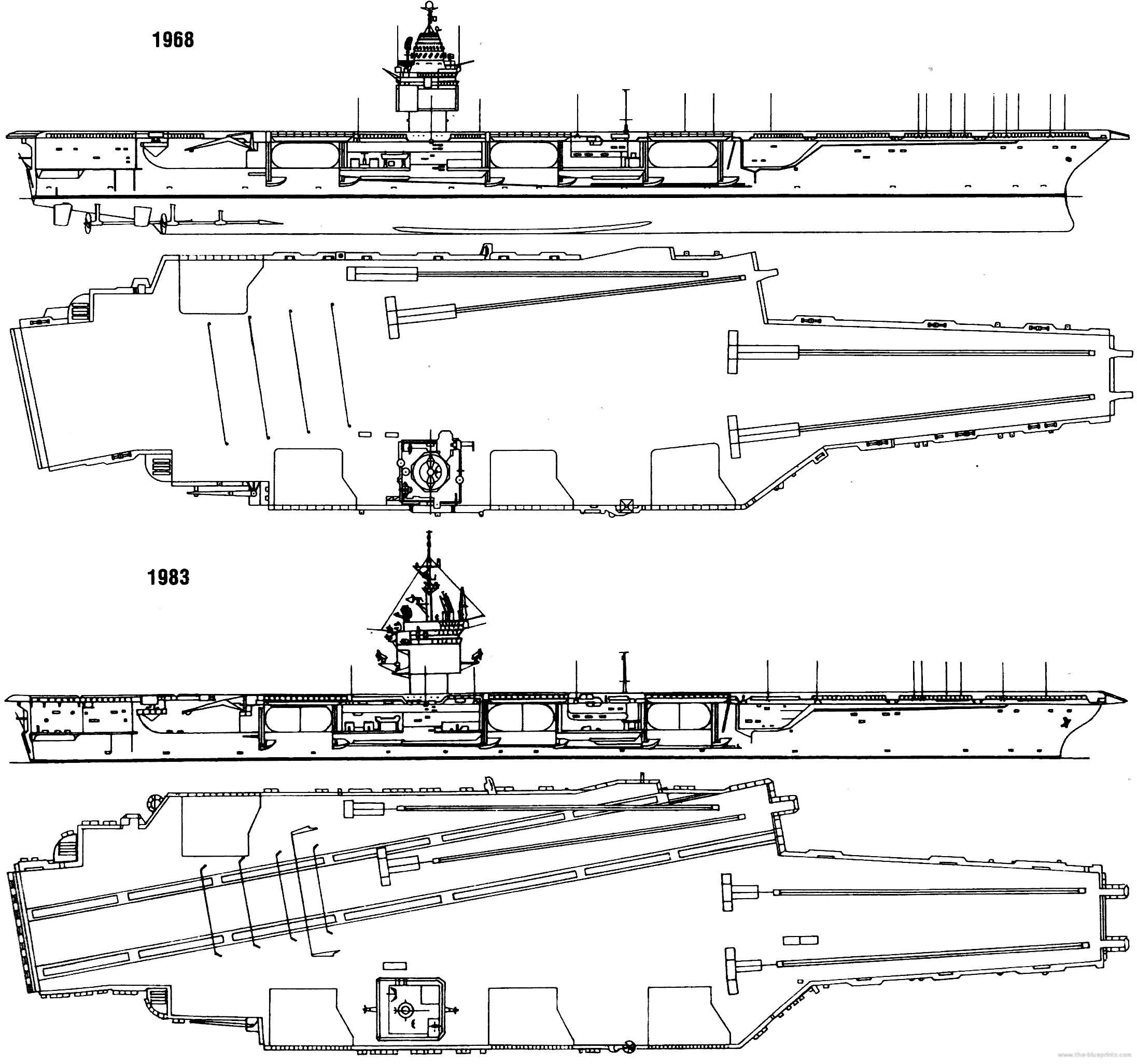
 Latest Facebook Entry -
Latest Facebook Entry -  X(Tweeter) Naval Encyclopedia's deck archive
X(Tweeter) Naval Encyclopedia's deck archive Instagram (@navalencyc)
Instagram (@navalencyc)





 French Navy
French Navy Royal Navy
Royal Navy Russian Navy
Russian Navy Armada Espanola
Armada Espanola Austrian Navy
Austrian Navy K.u.K. Kriegsmarine
K.u.K. Kriegsmarine Dansk Marine
Dansk Marine Nautiko Hellenon
Nautiko Hellenon Koninklije Marine 1870
Koninklije Marine 1870 Marinha do Brasil
Marinha do Brasil Osmanlı Donanması
Osmanlı Donanması Marina Do Peru
Marina Do Peru Marinha do Portugal
Marinha do Portugal Regia Marina 1870
Regia Marina 1870 Nihhon Kaigun 1870
Nihhon Kaigun 1870 Preußische Marine 1870
Preußische Marine 1870 Russkiy Flot 1870
Russkiy Flot 1870 Svenska marinen
Svenska marinen Søværnet
Søværnet Union Navy
Union Navy Confederate Navy
Confederate Navy Armada de Argentina
Armada de Argentina Imperial Chinese Navy
Imperial Chinese Navy Marinha do Portugal
Marinha do Portugal Mexico
Mexico Kaiserliche Marine
Kaiserliche Marine 1898 US Navy
1898 US Navy Sovietskiy Flot
Sovietskiy Flot Royal Canadian Navy
Royal Canadian Navy Royal Australian Navy
Royal Australian Navy RNZN Fleet
RNZN Fleet Chinese Navy 1937
Chinese Navy 1937 Kriegsmarine
Kriegsmarine Chilean Navy
Chilean Navy Danish Navy
Danish Navy Finnish Navy
Finnish Navy Hellenic Navy
Hellenic Navy Polish Navy
Polish Navy Romanian Navy
Romanian Navy Turkish Navy
Turkish Navy Royal Yugoslav Navy
Royal Yugoslav Navy Royal Thai Navy
Royal Thai Navy Minor Navies
Minor Navies Albania
Albania Austria
Austria Belgium
Belgium Columbia
Columbia Costa Rica
Costa Rica Cuba
Cuba Czechoslovakia
Czechoslovakia Dominican Republic
Dominican Republic Haiti
Haiti Hungary
Hungary Honduras
Honduras Estonia
Estonia Iceland
Iceland Eire
Eire Equador
Equador Iran
Iran Iraq
Iraq Latvia
Latvia Liberia
Liberia Lithuania
Lithuania Mandchukuo
Mandchukuo Morocco
Morocco Nicaragua
Nicaragua Persia
Persia San Salvador
San Salvador Sarawak
Sarawak Uruguay
Uruguay Venezuela
Venezuela Zanzibar
Zanzibar Warsaw Pact Navies
Warsaw Pact Navies Bulgaria
Bulgaria Hungary
Hungary

 Bundesmarine
Bundesmarine Dutch Navy
Dutch Navy Hellenic Navy
Hellenic Navy Marina Militare
Marina Militare Yugoslav Navy
Yugoslav Navy Chinese Navy
Chinese Navy Indian Navy
Indian Navy Indonesian Navy
Indonesian Navy JMSDF
JMSDF North Korean Navy
North Korean Navy Pakistani Navy
Pakistani Navy Philippines Navy
Philippines Navy ROKN
ROKN Rep. of Singapore Navy
Rep. of Singapore Navy Taiwanese Navy
Taiwanese Navy IDF Navy
IDF Navy Saudi Navy
Saudi Navy Royal New Zealand Navy
Royal New Zealand Navy Egyptian Navy
Egyptian Navy South African Navy
South African Navy






























 Ukrainian Navy
Ukrainian Navy dbodesign
dbodesign
The 3rd Med Deployment in 1988 is partly incorrect. We were a 7th fleet ship and sailed from Alameda NAS to Gonzo Station in the North Arabian Sea. There was no entering the Med or going through the Suez that cruise. The rest was accurate.
Many thanks for this precision Jeff !
Text fixed.
David